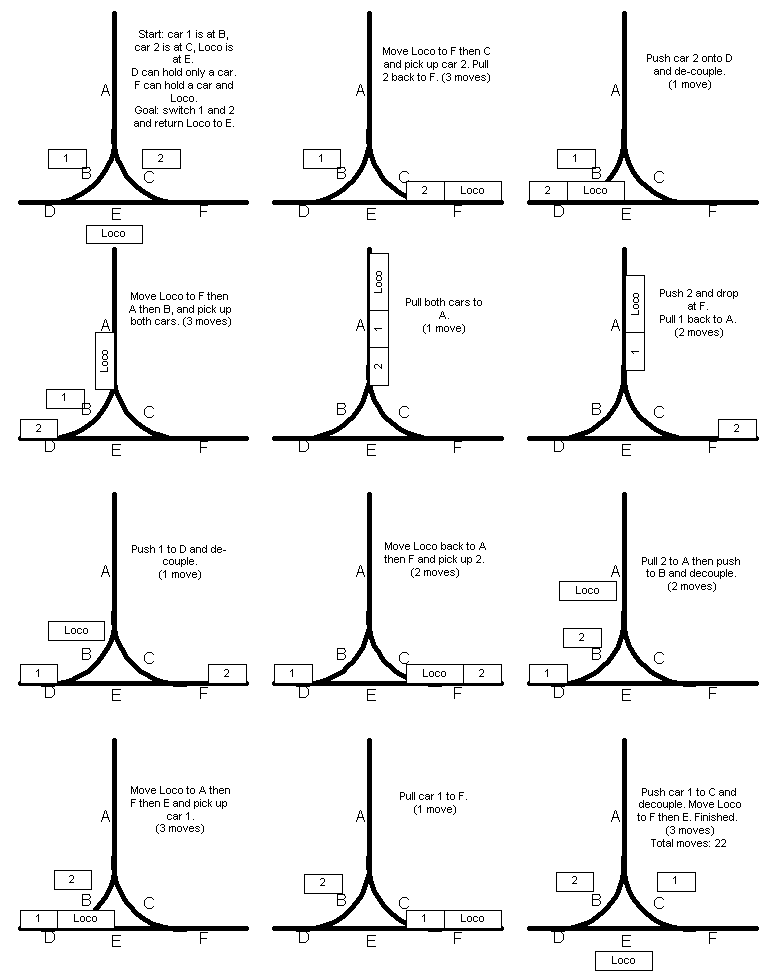

 The puzzles in this section have pieces that slide, without lifting or jumping,
from one position to another, and a space into which to slide the pieces.
This definition is from the foremost book about this category of puzzle,
Sliding Piece Puzzles by L.E. (Edward) Hordern,
which was published in 1986 by Oxford University Press
as part of the
Recreations in Mathematics series edited by David Singmaster.
The book describes more than 270 sliding piece puzzles (also known as sliding block puzzles) and provides solutions.
(Actually, though, some modern "sliding piece" puzzles permit lifting the pieces.
I'll include them in section F.)
The Cleverwood website (defunct) had
an informative excerpt (archive.org)
from a precursor work by Hordern.
You can try some
sliding block puzzles on-line at Nick Baxter's site hosted by John Rausch, including many designed by Minoru Abe and
Serhiy Grabarchuk.
You can also play Java versions on-line at
janko.at, a German site.
Try the
Bulbous Blob online at
Puzzlebeast.
See
this article by Ed Pegg, Jr. on sliding-block puzzles
for an excellent survey.
See Taniguchi's Programs page for a solver program.
The puzzles in this section have pieces that slide, without lifting or jumping,
from one position to another, and a space into which to slide the pieces.
This definition is from the foremost book about this category of puzzle,
Sliding Piece Puzzles by L.E. (Edward) Hordern,
which was published in 1986 by Oxford University Press
as part of the
Recreations in Mathematics series edited by David Singmaster.
The book describes more than 270 sliding piece puzzles (also known as sliding block puzzles) and provides solutions.
(Actually, though, some modern "sliding piece" puzzles permit lifting the pieces.
I'll include them in section F.)
The Cleverwood website (defunct) had
an informative excerpt (archive.org)
from a precursor work by Hordern.
You can try some
sliding block puzzles on-line at Nick Baxter's site hosted by John Rausch, including many designed by Minoru Abe and
Serhiy Grabarchuk.
You can also play Java versions on-line at
janko.at, a German site.
Try the
Bulbous Blob online at
Puzzlebeast.
See
this article by Ed Pegg, Jr. on sliding-block puzzles
for an excellent survey.
See Taniguchi's Programs page for a solver program.
In Sliding Piece Puzzles, Hordern defines four categories:
|
The first category is further subdivided into the following subgroups, which Hordern labels A through G:
|
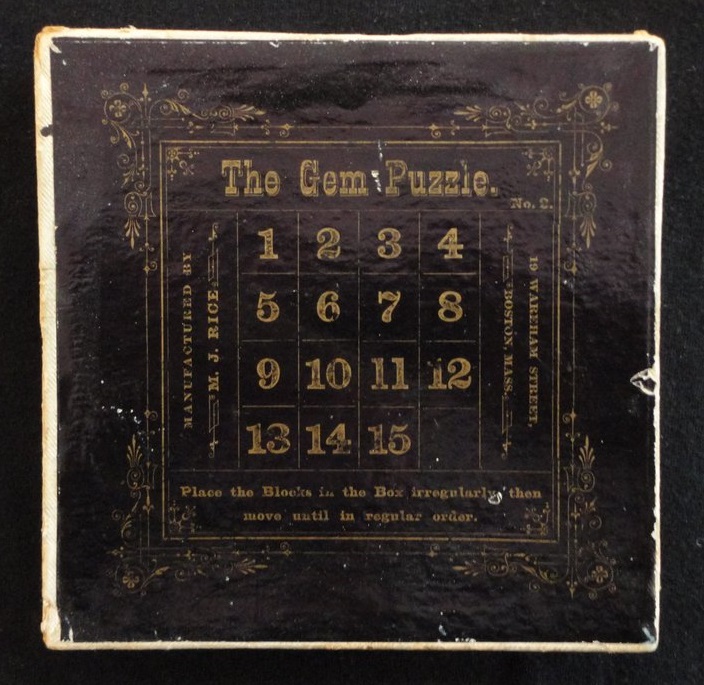
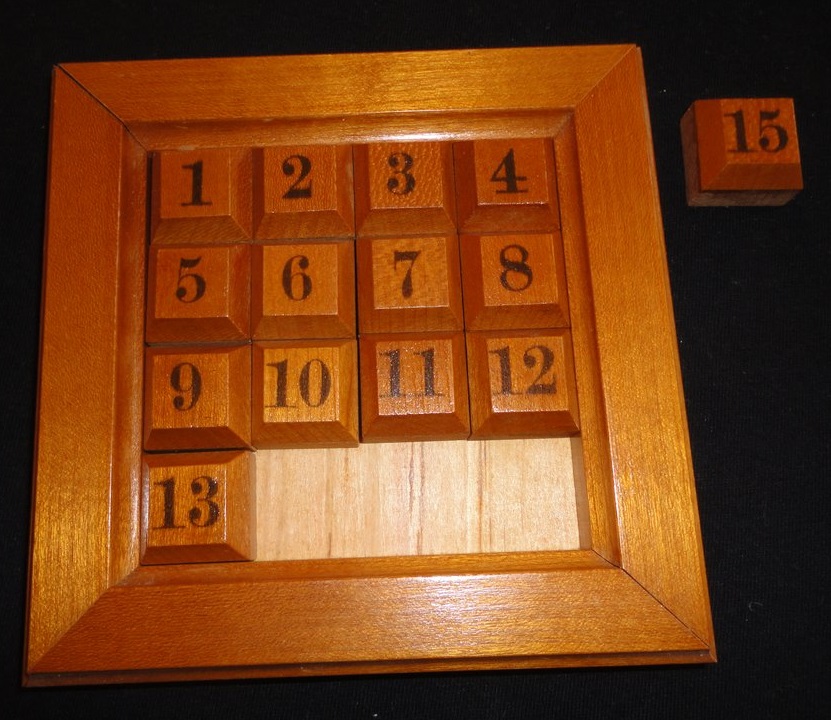 The most well-known sliding-block puzzle is the "Fifteen" (or "15") puzzle.
Over a century before Rubik's Cube, in 1880, the Fifteen puzzle started one of the first puzzle crazes to occupy America and Europe.
The Fifteen puzzle was first marketed in Boston by Matthias J. Rice, who called it "The Gem Puzzle."
It was a tray containing fifteen numbered wooden blocks.
The box top provided simple instructions:
"Place the blocks in the box irregularly, then move until in regular order."
The ambiguity of these instructions contributed to the popularity of the puzzle.
I found a copy but I am missing the "14" piece.
It was eventually proved that half the random arrangements can be solved, while the other half are impossible.
We now distinguish the solvable from the unsolvable arrangements by checking their "parity" -
which amounts to the number of pairs which must
be swapped to restore regular order. If the parity proves even, the position is solvable - if odd, unsolvable.
This did not prevent people from claiming to have solved impossible arrangements.
Most often their "solution" entailed some way of re-defining the goal state - for instance
placing the empty space elsewhere than at the lower right,
ordering the numbers in some way other than left to right in rows down the tray, or making use of a rotation of the tray itself
(thusly leaving the figures not right-side up, or employing round tiles so as to be able to re-right them afterwards).
The most well-known sliding-block puzzle is the "Fifteen" (or "15") puzzle.
Over a century before Rubik's Cube, in 1880, the Fifteen puzzle started one of the first puzzle crazes to occupy America and Europe.
The Fifteen puzzle was first marketed in Boston by Matthias J. Rice, who called it "The Gem Puzzle."
It was a tray containing fifteen numbered wooden blocks.
The box top provided simple instructions:
"Place the blocks in the box irregularly, then move until in regular order."
The ambiguity of these instructions contributed to the popularity of the puzzle.
I found a copy but I am missing the "14" piece.
It was eventually proved that half the random arrangements can be solved, while the other half are impossible.
We now distinguish the solvable from the unsolvable arrangements by checking their "parity" -
which amounts to the number of pairs which must
be swapped to restore regular order. If the parity proves even, the position is solvable - if odd, unsolvable.
This did not prevent people from claiming to have solved impossible arrangements.
Most often their "solution" entailed some way of re-defining the goal state - for instance
placing the empty space elsewhere than at the lower right,
ordering the numbers in some way other than left to right in rows down the tray, or making use of a rotation of the tray itself
(thusly leaving the figures not right-side up, or employing round tiles so as to be able to re-right them afterwards).
 Jerry Slocum and Dic Sonneveld put out a book on the history of the 15 puzzle.
In the book, they reveal that although
Sam Loyd claimed
and often got inappropriate credit for its invention,
the actual inventor was Noyes Chapman, a postmaster in Canastota, New York,
who applied for a patent in 1880.
The patent was denied, perhaps because the 15 Puzzle was too similar to
207124
207124
-
Kinsey 1878,
which specified the tongue-and-groove
arrangement now commonly used for holding the tiles in the tray.
Sam Loyd really shouldn't even be credited with popularizing the impossible challenge called "14-15"
in which the starting position has
only the 14 and 15 tiles swapped.
The probable impossibility of that challenge was already appreciated back during the original craze.
Since this position has odd parity, it cannot be solved.
Loyd must have felt secure in offering a $1000 prize for a solution!
Hordern categorizes the Fifteen puzzle (along with the 14-15) as B10, rather than in the A group -
probably because only a specific subset of starting positions is solvable.
Hordern's first puzzle in the A group, A1, is RATE YOUR MIND PAL.
It can always be solved, regardless of the initial position of the blocks.
Bearing in mind the parity issue, can you figure out why?
Jerry Slocum and Dic Sonneveld put out a book on the history of the 15 puzzle.
In the book, they reveal that although
Sam Loyd claimed
and often got inappropriate credit for its invention,
the actual inventor was Noyes Chapman, a postmaster in Canastota, New York,
who applied for a patent in 1880.
The patent was denied, perhaps because the 15 Puzzle was too similar to
207124
207124
-
Kinsey 1878,
which specified the tongue-and-groove
arrangement now commonly used for holding the tiles in the tray.
Sam Loyd really shouldn't even be credited with popularizing the impossible challenge called "14-15"
in which the starting position has
only the 14 and 15 tiles swapped.
The probable impossibility of that challenge was already appreciated back during the original craze.
Since this position has odd parity, it cannot be solved.
Loyd must have felt secure in offering a $1000 prize for a solution!
Hordern categorizes the Fifteen puzzle (along with the 14-15) as B10, rather than in the A group -
probably because only a specific subset of starting positions is solvable.
Hordern's first puzzle in the A group, A1, is RATE YOUR MIND PAL.
It can always be solved, regardless of the initial position of the blocks.
Bearing in mind the parity issue, can you figure out why?
|
In his 1942 book 100 Puzzles - How to Make and Solve Them,
Anthony Filipiak describes and provides solutions for ten "shifting block" puzzles, most of which are covered by Hordern. |
|||||

|
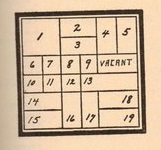
19 Block - H.C71 |
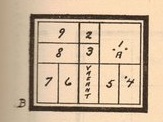
9 Block - H.C19 Dad's Puzzle |
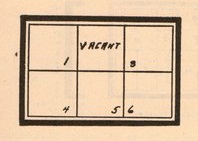
5 Block - H.B1 - Sam Loyd's The Moving Day Puzzle |
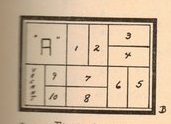
11 Block - H.C52 |
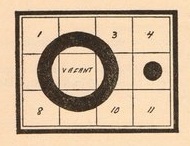
Bull's Eye (11 blocks) - H.B23 ZOT |
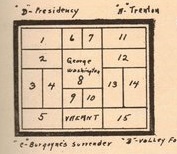
George Washington's Career (15 blocks) - H.C67 |
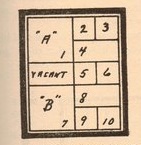
10 Block - H.C17 Schweig's Trans-Atlantic |
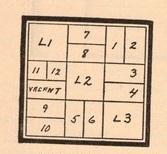
15 Block or 1-2-3 - H.C72 |
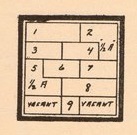
Rectangle - H.D1-3 Ma's Puzzle |
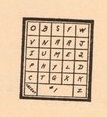
27 Block |
|
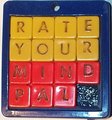 A1 RATE YOUR MIND PAL Plas-Trix |
  A3 Franklyn's Tobacco Puzzle When solved, it reads "Smoke Franklyns Fine Shagg It Is Good." |
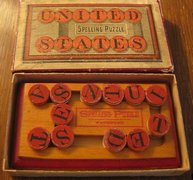
United States I don't have it. Start with the blocks in random positions, finish as shown. Black squares are impassable. |
||||||||||||||||||
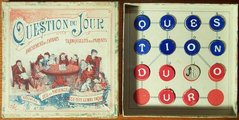 A5 Question du Jour (aka La Grande Question or the Columbia Puzzle) |
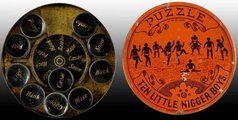 A6 Ten Little N****r Boys See U.S. patent 602735 602735 - Donaldson 1898. Also see 437932 437932 - McGrath 1890. (I don't have this.) |
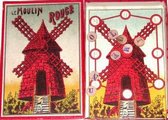 A7 Le Moulin Rouge |
||||||||||||||||||
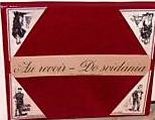
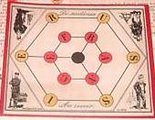
A8 Au revoir, Do svidania 1893 (I don't have this.) |
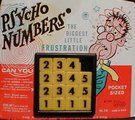 A9 Latin Square variants such as the Roalex Psycho Numbers (I don't have this.) |
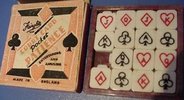 A10 Four Square (aka Court Card by Fairylite) Objective is a Graeco-Latin Square. See U.S. patent 433444 433444 - Brown 1890. (I don't have this.) |
||||||||||||||||||
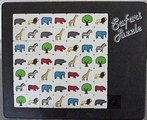 Safari Another Latin square. |
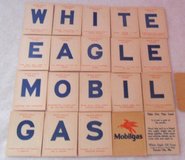
The White Eagle Mobil Gas puzzle Shuffle the 19 cards, place in four horizontal rows of five cards each, letter side up, leaving one open space (at lower right). Slide cards left/right & up/down, using the open space, until they read "White Eagle Mobil Gas" followed by the symbol card and the space. |
|||||||||||||||||||
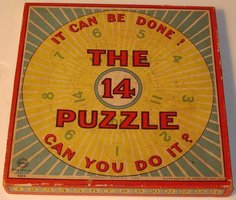
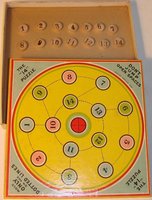
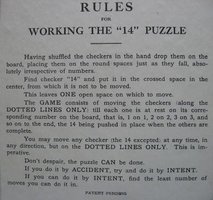
The 14 Puzzle - Milton Bradley Drop the pieces on the board randomly - place each on its nearest space. Find 14 and put it in the center and don't move it until the end. Using the single open space, move the pieces along the dotted lines only, until each piece rests on the corresponding numbered space. Move 14 into place last. |
||||||||||||||||||||
The Moving Day Puzzle eq. to the 5 Block Puzzle in Filipiak Five square (1x1) blocks in a 2x3 tray. Exchange B and I in the fewest moves. I don't know if this was ever produced as a physical puzzle - I don't have it and I don't have a photo, but it is easy to emulate (I made one from Lego) and I think it is a great little puzzle to try. See the Moving Day Puzzle in an online version of Sam Loyd's Cyclopedia at Ed Pegg's site. Play it online at janko.at or at Nick Baxter's site. |
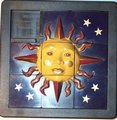 B5 (B4 thru B8) Eight Block Puzzle (various start and end conditions) A 3x3 grid with one space and eight uniform blocks. Many variations exist, including this Sun Face. Play B6, Dudeney's Letter Block, online at janko.at or Nick Baxter's site. |
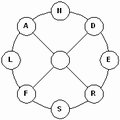 B9 The Flanders Wheel From Puzzles and Curious Problems by H. Dudeney ca.1917 I don't have it or a photo. Move the pieces along the lines from spot to spot starting with the arrangement shown, so FLANDERS can be read clockwise beginning with the F at 12 o'clock. |
||||||||||||||||||||||||||||||||||
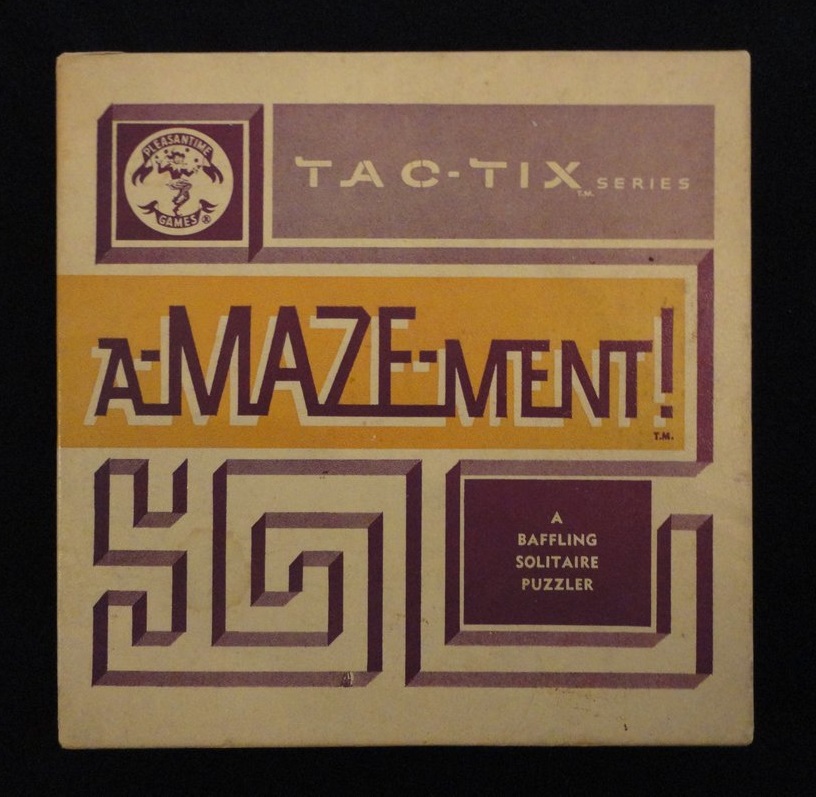
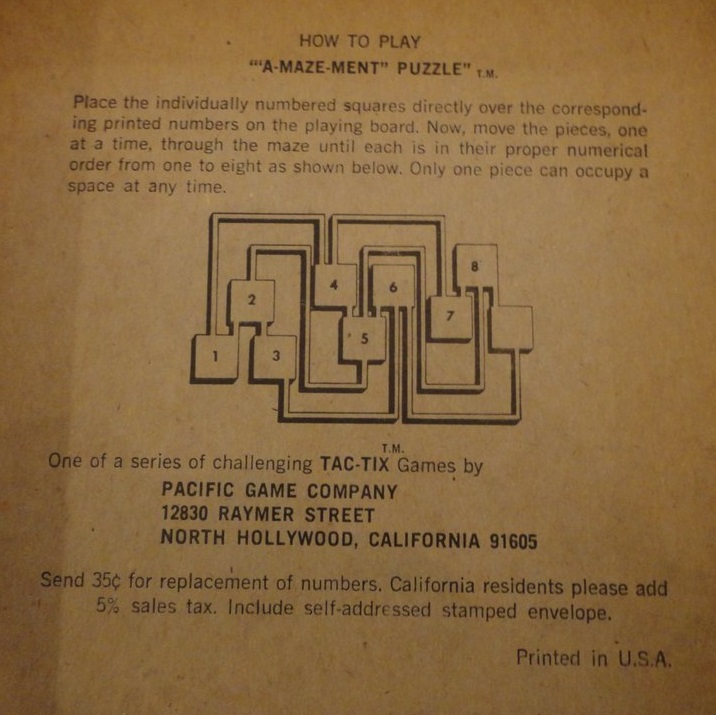
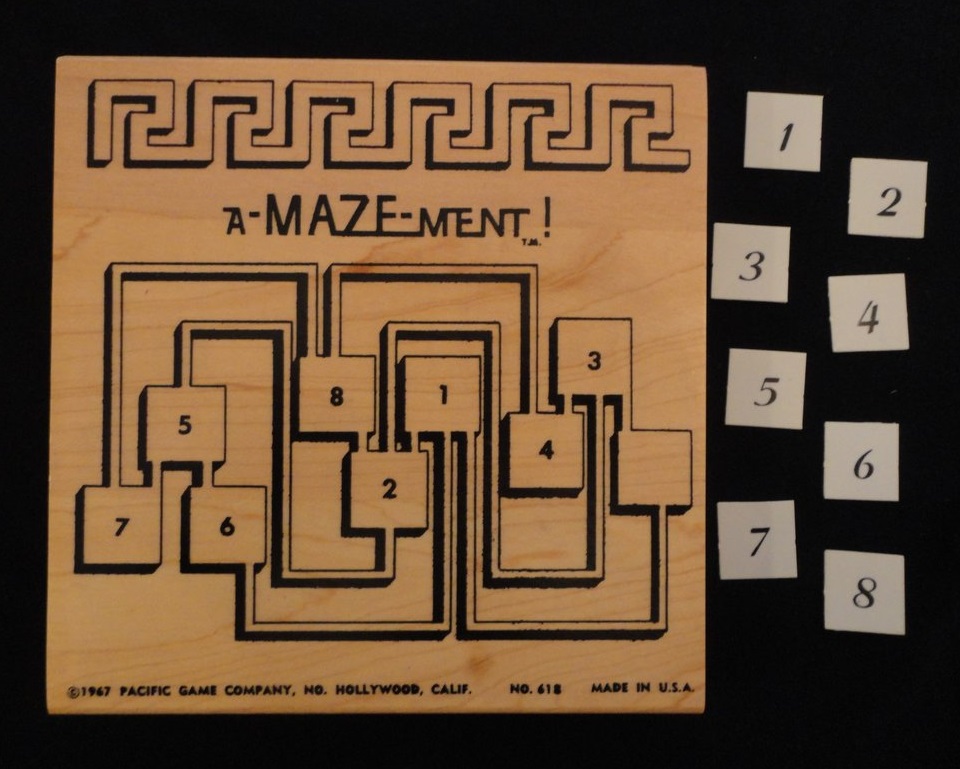
A-Maze-Ment in the Pleasantime Games Tac-tix series from Pacific Game Co. 1967 A vintage sliding piece puzzle Start with the eight numbered tokens on the board as printed. Move one at a time along the connections, using the blank space, until they are in left-to-right numeric order. This is topologically equivalent to an 8-piece puzzle in a 3x3 grid with one blank.
|
||||||||||||||||||||||||||||||||||||
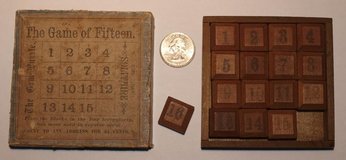
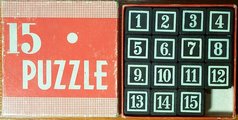


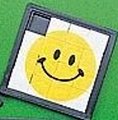
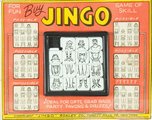 B10 The Fifteen Puzzle There have been countless variations produced, including an early wooden version from the Embossing Co. of NY, a nice metal version from Binary Arts and a cheap plastic smiley-face version. B11-B15 are variations, some to form magic squares rather than order the numbers. |
||||||||||||||||||||||||||||||||||||
B13 A variant of the 15 Puzzle. Start with the first arrangement, remove the 16, and slide the blocks to get to the second arrangement. |
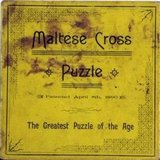
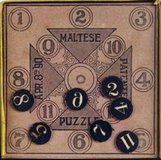
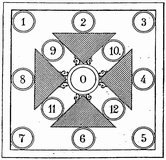
The Maltese Cross Puzzle Advertising item for Hires Root Beer (I don't have this.) U.S. Patent D0019756 - Spayd 1890 I can't find this in Hordern. |
|||||||||||||||||||||||||||||||||||
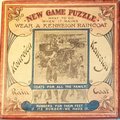
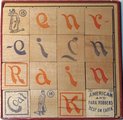 Kenreign Rain Coat New Puzzle Game |
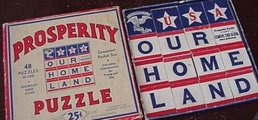 Prosperity Puzzle |
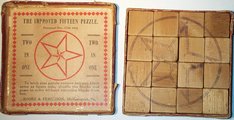 The Improved 15 (Star) Puzzle |
||||||||||||||||||||||||||||||||||
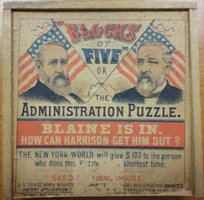
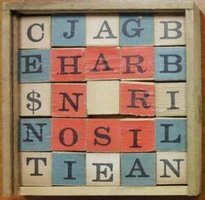
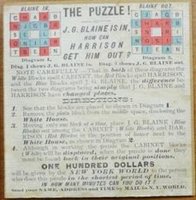
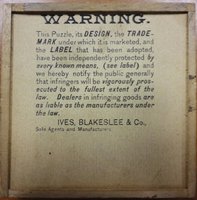
"Blocks of Five" or the Administration Puzzle Blaine is in. How can Harrison get him out? (I don't have this - shown for reference.) To start, put Harrison around the outside instead of JG Blaine - end as shown. The center (representing the White House) is the empty square. The CABINET$ will be moved as needed during solving but must start and end arranged as shown. |
||||||||||||||||||||||||||||||||||||
The Fifteen Puzzle (variation from Wit Sharpeners 1944) I don't have it or a photo. Slide the numbers to create a magic square where all rows, columns, and the two main diagonals add to 15. |

 B18 Panama Canal I don't have it. Play it online at janko.at or at Nick Baxter's site. |
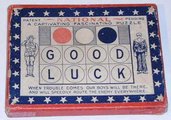
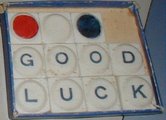 B19,B20 Good Luck 1919 B19: Exchange rows 1 and 2 intact. B20: Move row 1 to bottom, all rows end intact. |
||||||||||||||||||||||||||||||||||
Capturing the Kaiser / Tit-Bits New Game 1914-18, 1930s I don't have it or a photo. Surround Kaiser Wilhelm, Von Tirpitz, the Crown Prince, and Count Zeppelin with soldiers. Could this be the elusive Tit-Bits Teaser No. 3? |
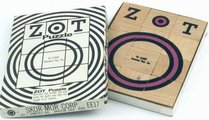 B23 ZOT Skor-Mor B24 is a variant called "ZOX" where the T is replaced by an X. In ZOX, the Z and X must end up in the same relative positions as at the start. This will require some lateral thinking! B25 is a further variation, by N. Takashima. |
B28 Dormitory Dash - Peterson Games 1975 |
||||||||||||||||||||||||||||||||||
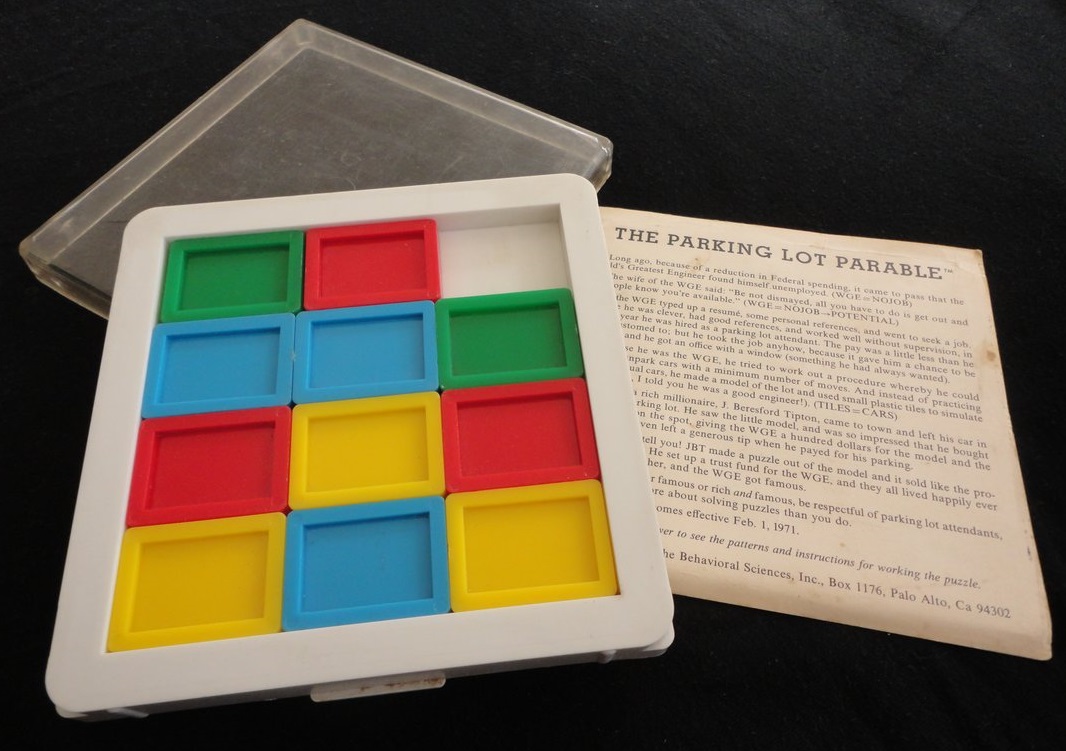
The Parking Lot Parable 1971 Products of the Behavioral Sciences, Inc. Palo Alto CA Start with the colored tiles as shown at left (white is space); end with no two tiles of the same color touching. The instructions say 24 moves; Hordern says 20 moves. |
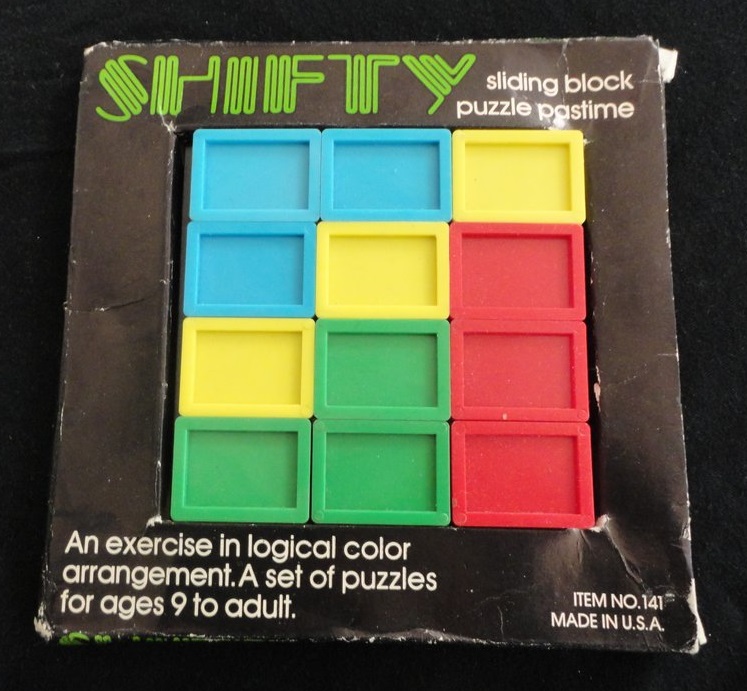
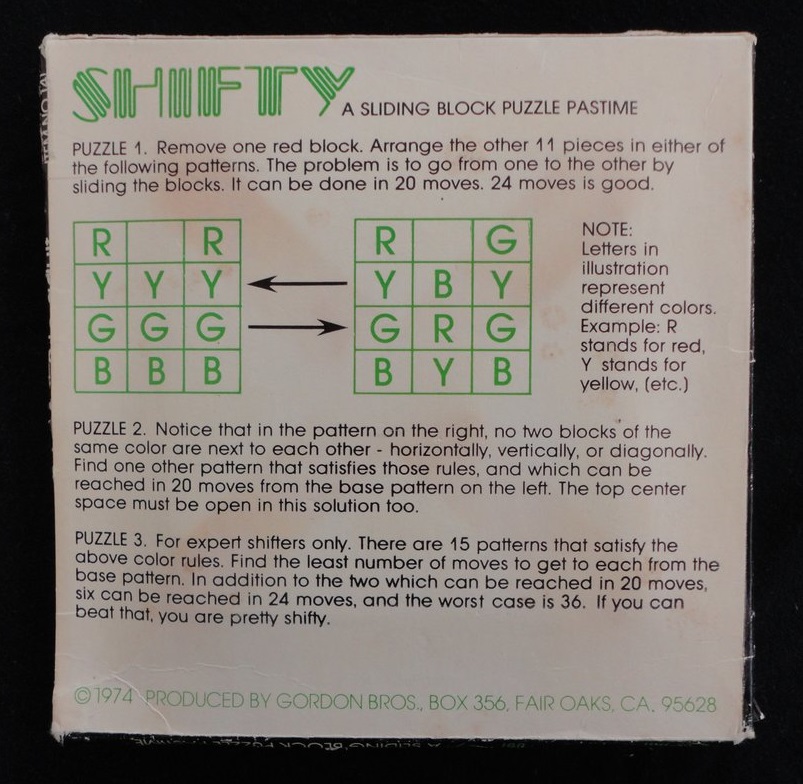
Shifty Gordon Bros. 1974 Shifty is equal to The Parking Lot Parable but poses additional challenges using the same pieces. |
|||||||||||||||||||||||||||||||||||
A Motor-Car Problem Dudeney 1903 I don't have it or a photo. Image is of a Russian version called Logi Toli. Exchange 1/4, 2/5, 3/6. This is the "three-letter" version of B35. |
 B34 Switchit |
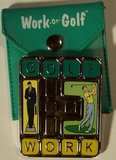 B35 Work or Golf (aka A Motor Garage Puzzle) Play online at janko.at or at Nick Baxter's site. See B33,B34 for the "three-letter" version of this four-letter puzzle. B36 extends both words to five letters, and adds another "siding" space opposite the existing one. |
||||||||||||||||||||||||||||||||||
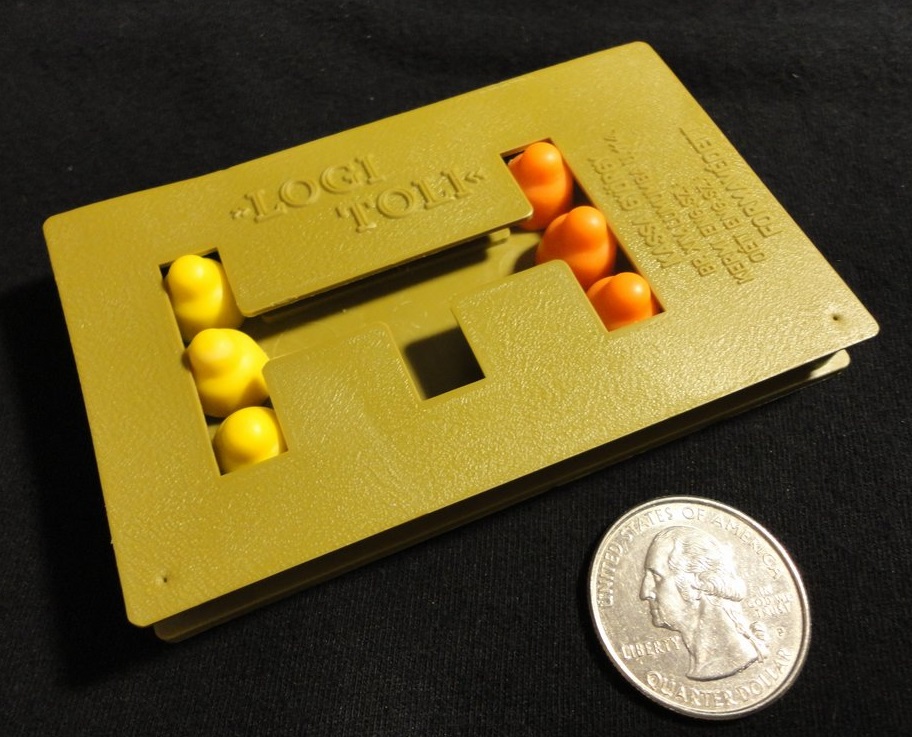
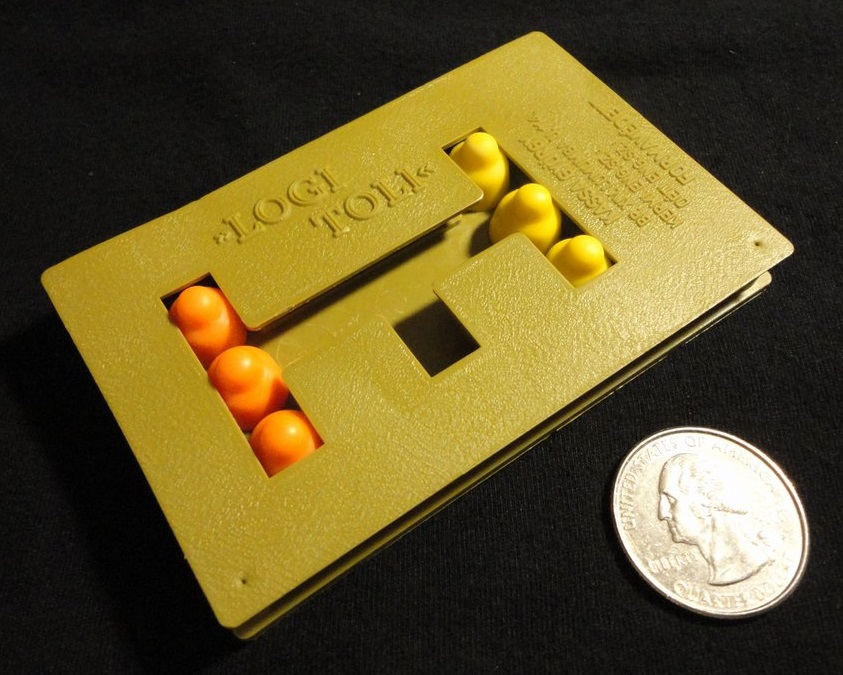
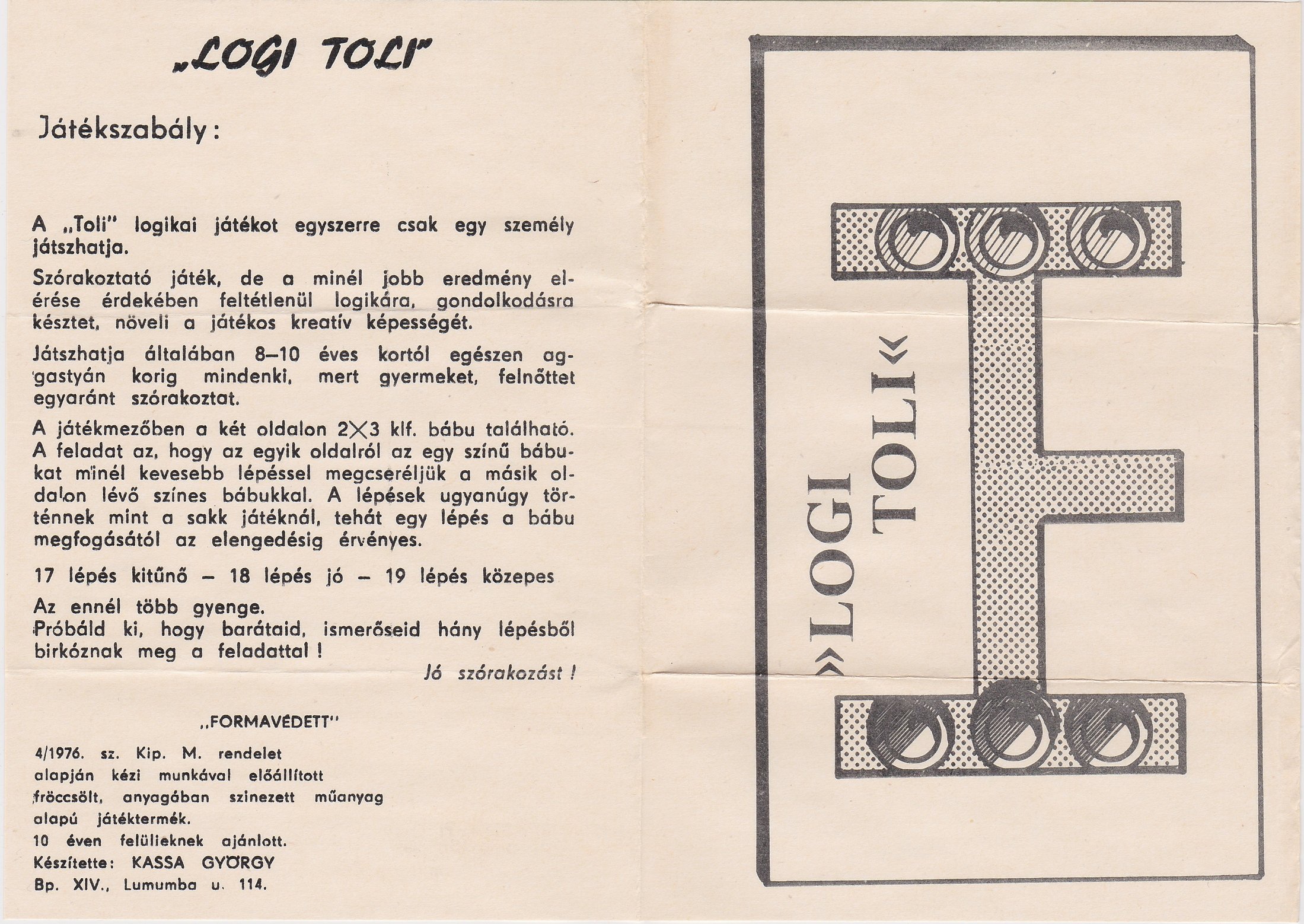
Logi Toli - a vintage sliding piece puzzle from Hungary With original instruction sheet. Peter Gal posted a nice blog entry about Logi Toli, including a state map. |
||||||||||||||||||||||||||||||||||||
Nine Men in a Trench I don't have it. Play it online at janko.at or at Nick Baxter's site. 
B38 is a 1984 version from Hong Kong, where pieces 2-5 are one color, 6-9 a second color, and 1 a third color. You are to move 1 to the left side and swap the other two colored groups. The pic is from Martin Watson's collection. I don't have this. |
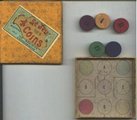
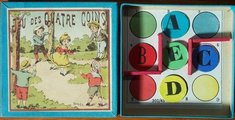 B41 So Easy / Le Jeu des Quatre Coins |
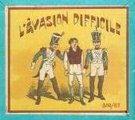
 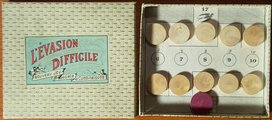 B42 L'Evasion Difficile (I have the plainer version.) |
||||||||||||||||||||||||||||||||||
Anagram Blocks From "Sam Loyd and His Puzzles" 1928. Rearrange the letters to spell "MAID ENLY" in two rows. I don't have it or a photo. |
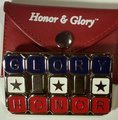 B44 Honor and Glory (Black and White) Play Black and White online at Nick Baxter's site. |
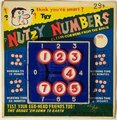 B46-49 Nutzy Numbers (aka Tantalising 7, Nutty Numbers) See U.S. Patent 3148884 3148884 - Steinhardt Sept. 1964 |
||||||||||||||||||||||||||||||||||
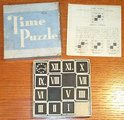 B50-59 The Time Puzzle by the Embossing Company of Albany NY. See patent 1989411 1989411 - 1935 |
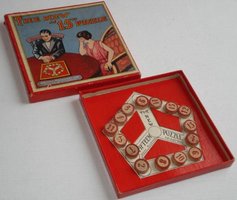 B60 The New 15 Puzzle 1923 |
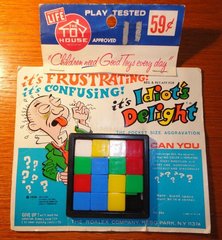 I found a copy of the Idiot's Delight sliding piece puzzle issued by Roalex.
I found a copy of the Idiot's Delight sliding piece puzzle issued by Roalex.
The goal is to move the pieces such that no color appears more than once in any row, column, or diagonal. The space must end in a corner. |
||||||||||||||||||||||||||||||||||
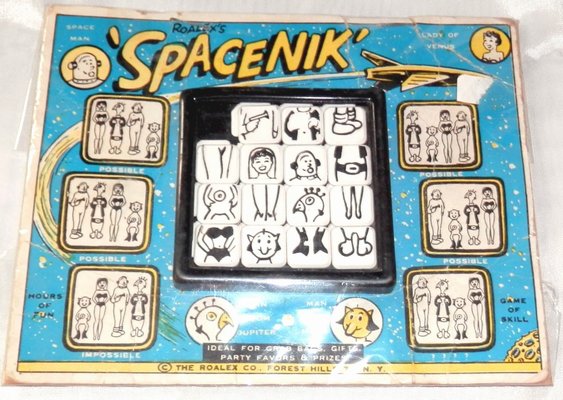
A vintage Spacenik from Roalex. |
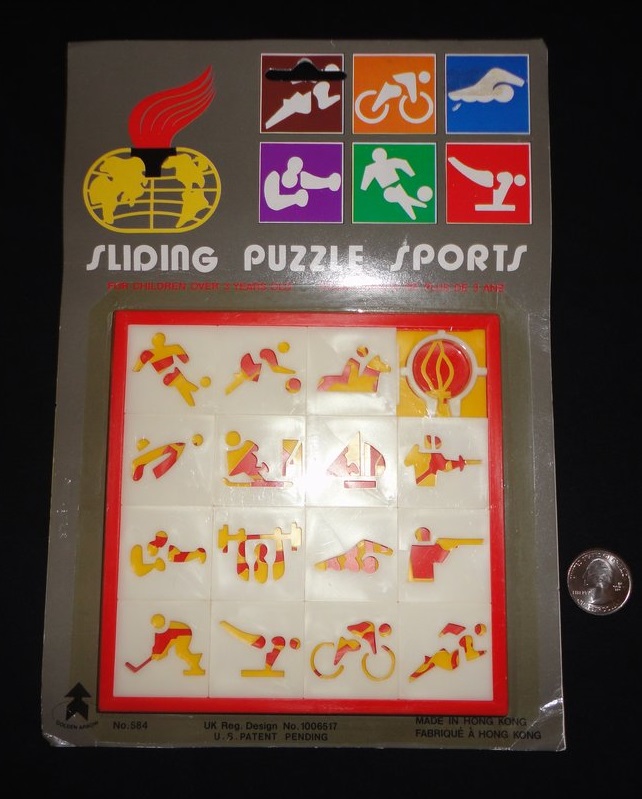
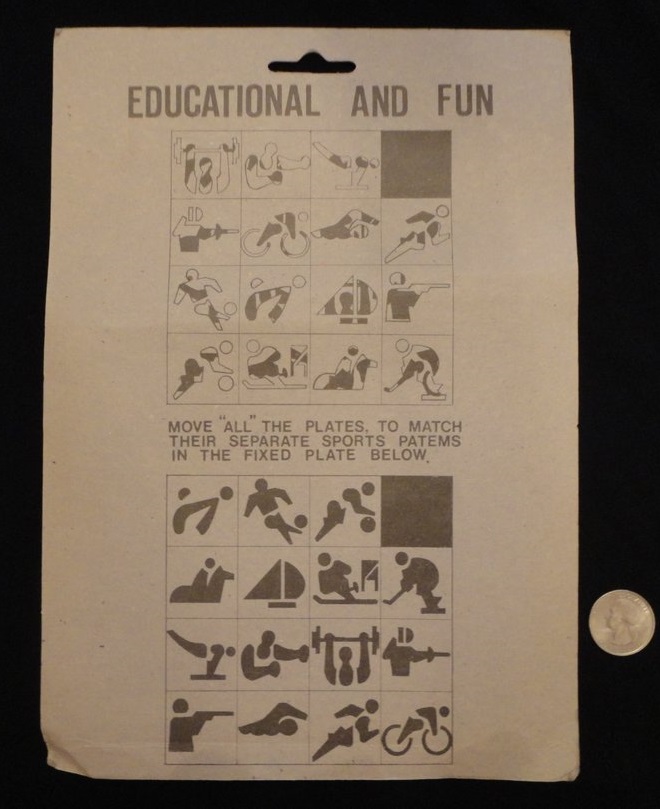
Sliding Puzzle Sports sliding piece puzzle with an Olympics theme. Made in Hong Kong. |
|||||||||||||||||||||||||||||||||||
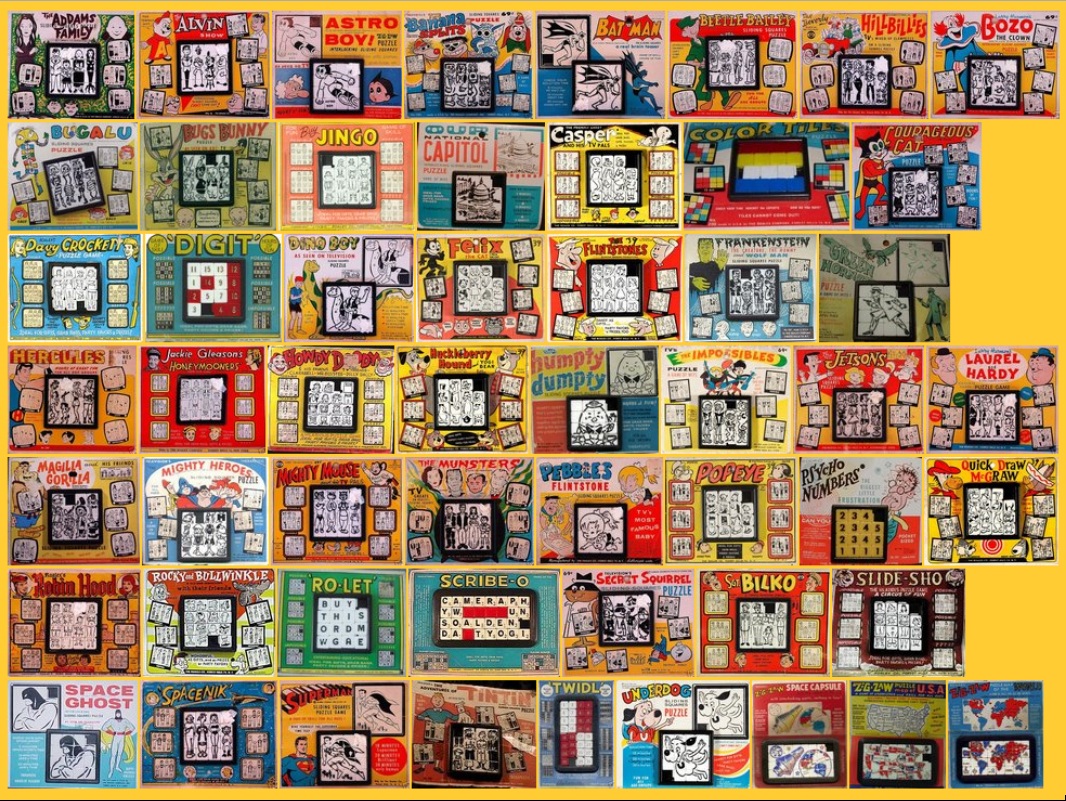
Many different challenges can be attempted using the 4x5 tray and the following set of pieces:
4x5 designs which require large numbers of moves to complete include Quzzle by Jim Lewis (84 moves), Quzzle-Killer by Bob Henderson and Gil Dogon (90 moves), and finally the Super-Century by Gil Dogon, which requires the largest number of moves (138) for a 4x5 tray using rectangular pieces.
U.S. Patent 516035 516035 - H. Walton 1894 Exchange A and B. I don't have it or a photo. |
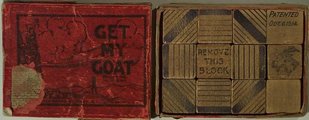 C2 Get My Goat (Should have one rectangular piece in upper right, else it becomes B23.) U.S. Patent 1112746 1112746 - Wiley 1914 Play online at Nick Baxter's site. |
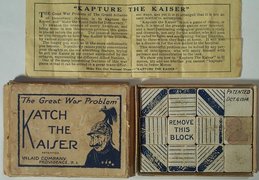 C2 Katch the Kaiser |
||||||||||||||||||||||
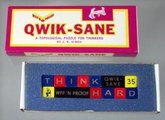 C3 Qwik-Sane |
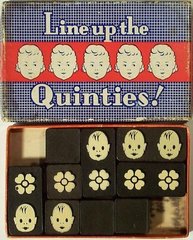 C4 Line Up the Quinties R. W. Fatiguant, 1934 Move the faces to form a line where the flowers are. Play it online at Nick Baxter's site. |
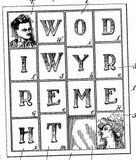
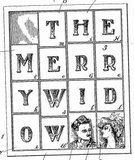
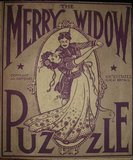
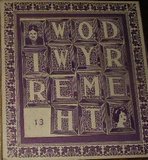
C5 The Merry Widow U.S. Patent 922002 922002 - Koehler 1909 (I don't have this.) Diagrams from patent - start as on left with "The Merry Widow" spelled backwards - small letters read "Will she get him" - end as on right. Note blocks are not all same size. Photos from actual puzzle - small letters are absent. |
||||||||||||||||||||||
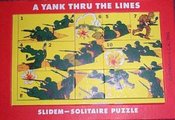 C6 A Yank Thru the Lines 1942 WWII Slidem-Solitaire Puzzle Electric Corporation of America, Chicago |
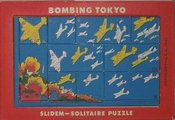 C7 Bombing Tokyo 1942 WWII Slidem-Solitaire Puzzle Electric Corporation of America, Chicago |
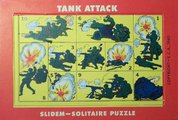
C8 Tank Attack 1942 WWII Slidem-Solitaire Puzzle Electric Corporation of America, Chicago |
||||||||||||||||||||||
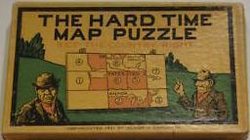
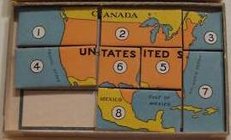
The Hard Time Map Puzzle (I don't have this.) |
||||||||||||||||||||||||
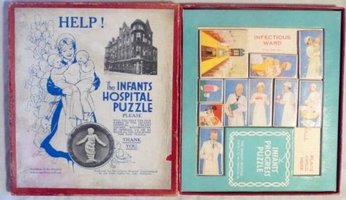
C12 The Infant's Hospital Puzzle Chad Valley 1920 I don't have this. Move A to the bottom right. The black area is impassable. There is a 1x3 gap and a 1x1 gap. |
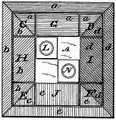 C14 Moss' Puzzle See U.S. Patent 668386 668386 - Frank E. Moss 1901 I don't have it or a photo - Hordern is unsure of whether this was ever produced. The sides labeled a,b,c, and d are different colors - rectangular pieces G,H,J, and I are correspondingly colored. Each starts across from its corresponding side and must end up as shown. The corner pieces C,D,E, and F are each bi-colored according to their home positions. They start out diagonally across from their homes. The two middle pieces L and N remain in the middle but their respective positions don't matter. |
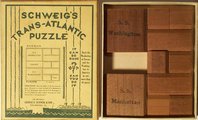 C17 The 10 Block Puzzle (Filipiak), aka Traffic Cop Tangle. Also appeared as Schweig's Transatlantic Puzzle. Play online at Nick Baxter's site. This puzzle was included in the "Party Puzzle Box Supreme" compendium from George Schweig & Son of Philadelphia PA. 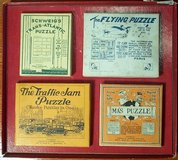
|
||||||||||||||||||||||
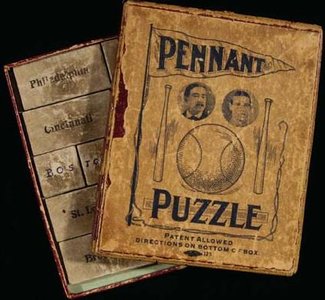
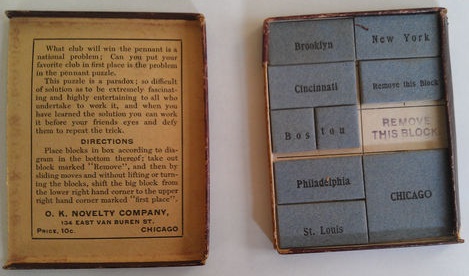
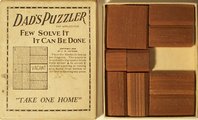
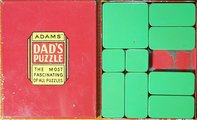
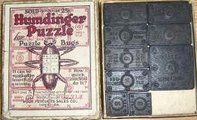
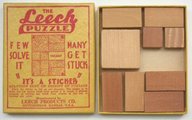
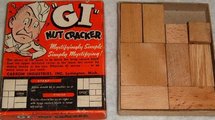
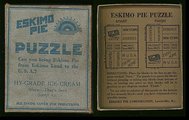
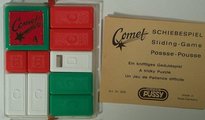
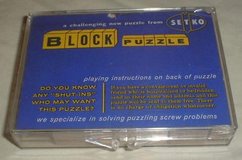
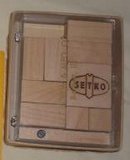
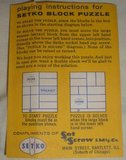

C19 The Pennant Puzzle aka Dad's Puzzle(r) The Pennant Puzzle was copyrighted in 1909 by Lewis W. Hardy, who had filed another patent (1017752 1017752 ) in 1907 which was not granted until 1912. The Humdinger, Leech, G.I. Nutcracker, Eskimo Pie, Comet, Setko Block, and Moving puzzles are the same. (I don't have the Pennant or Eskimo Pie versions. The Pennant, as baseball memorabilia, sold for $475! Thanks to Jan de Geus for pointing it out.) Play online at janko.at or Nick Baxter's site. |
||||||||||||||||||||||||
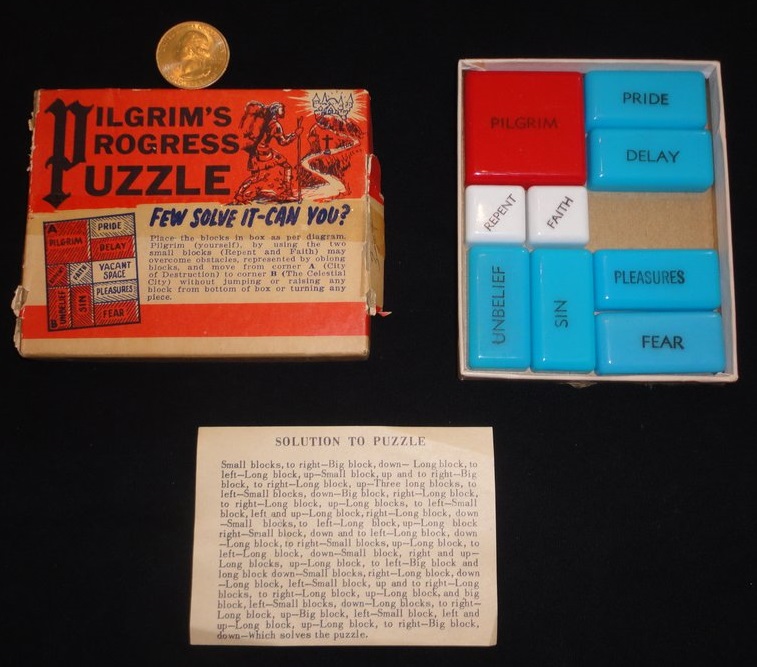
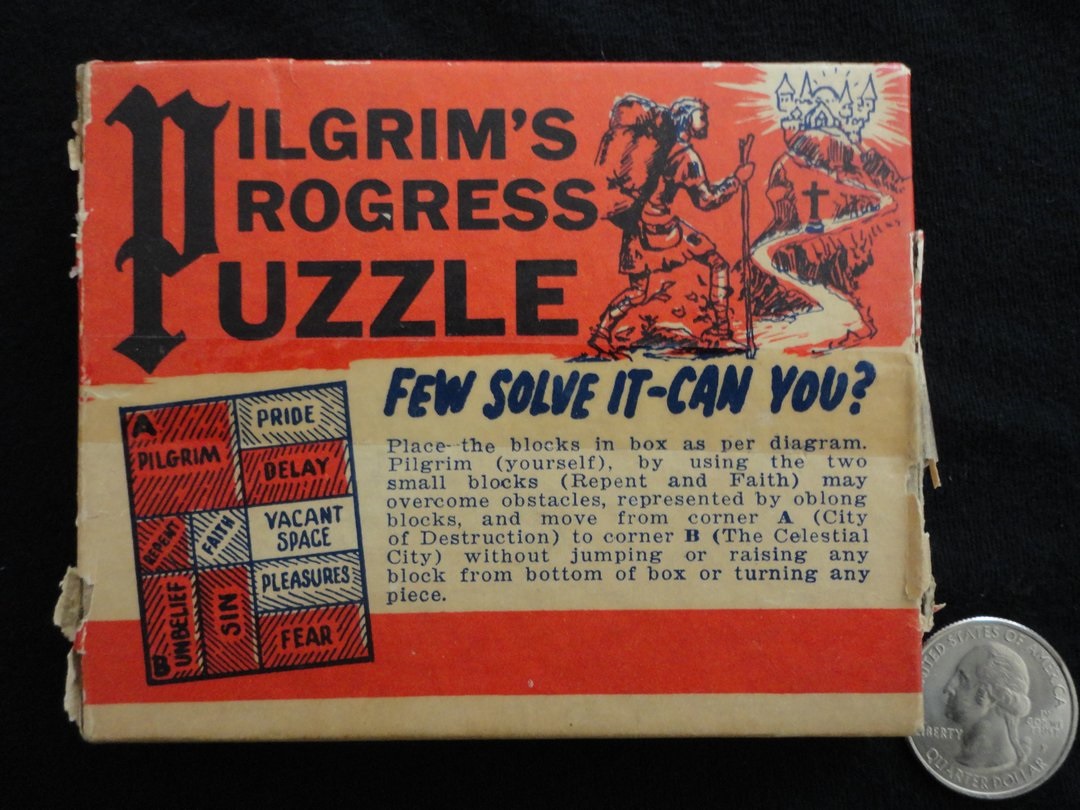
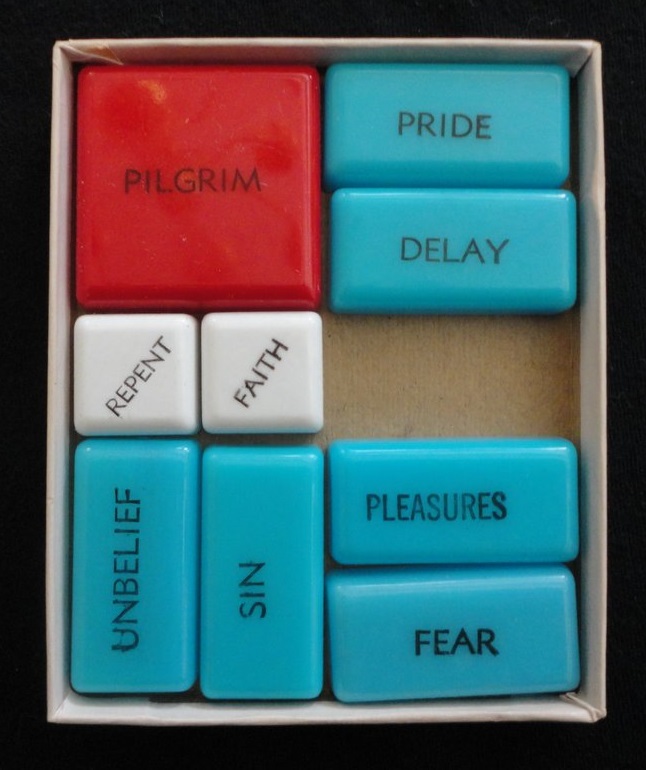
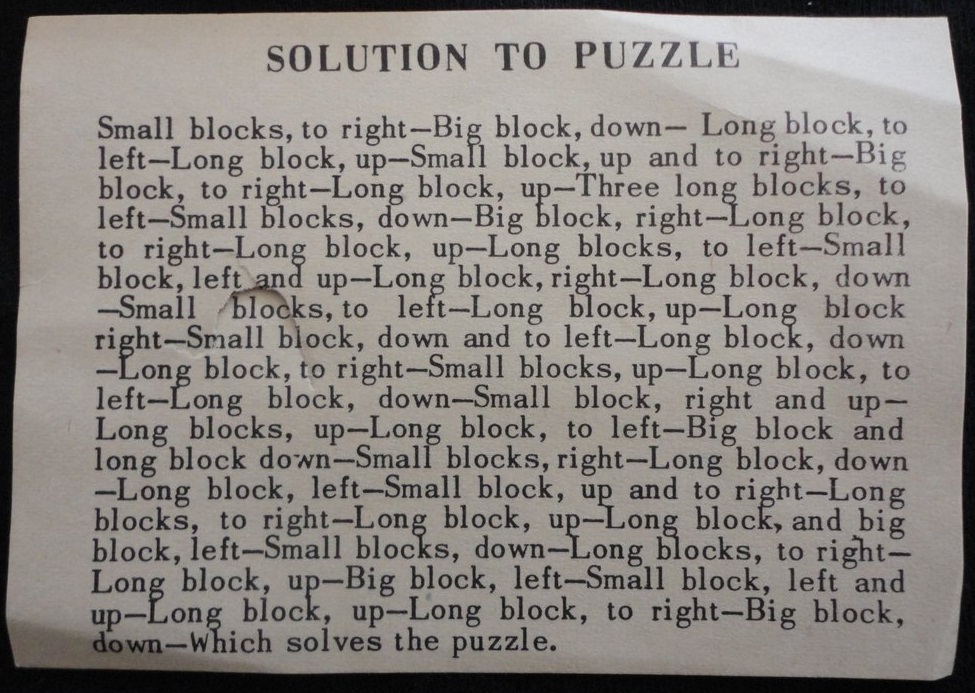
A vintage Pilgrim's Progress sliding piece puzzle |
||||||||||||||||||||||||
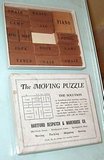
A vintage sliding piece puzzle advertising premium from the "Hartford Despatch & Warehouse Co." It's called The Moving Puzzle, but this is a 5x6 version I haven't seen before. |
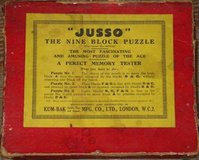
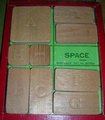
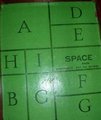 C20,21 Jusso Nine Block Puzzle |
|||||||||||||||||||||||
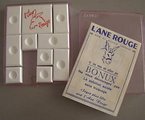
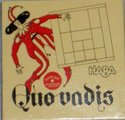
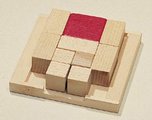
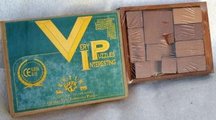
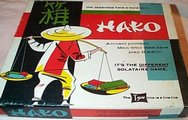
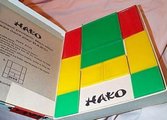
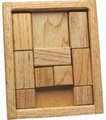
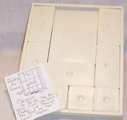
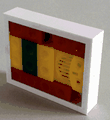
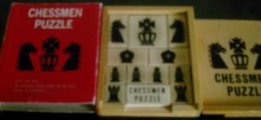
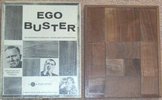
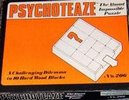
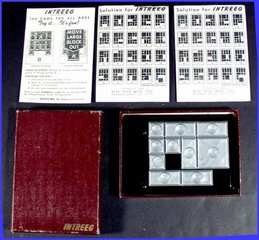
C27 L'Ane Rouge (The Red Donkey) Patented in England ( 411515) by J. H. Fleming in 1932. I have several modern versions, including a white plastic L'Ane Rouge, Haba's Quo Vadis, The VIP puzzle by Funtime Gifts Ltd., Tryne's Hako, Square Root, Hix Brix, Mintman (Mintman solution here) , (aka Klotski), the Chessmen, and Skor Mor's Ego Buster. This is also known in China as the Hua Rong Dao (Huarong Path), based on an escape of the warlord Cao Cao. In Japan, it is known as "Daughter in the Box." Other versions include Psychoteaze (which I don't have), and Intreeg (1949). Play online at janko.at or Nick Baxter's site. |
||||||||||||||||||||||||
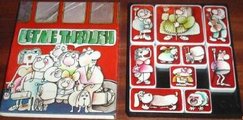 C28 Let Me Through |
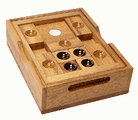 C31-40 Khun Phan (or Khum Pan) |
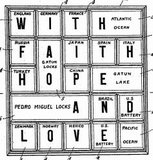
C48,49 Panama Blockade (I don't have this.) U.S. Patent 1415625 1415625 - Bulister 1922 |
||||||||||||||||||||||
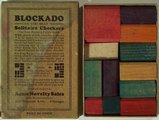 For some reason, Hordern omits Blockado. It is played on a 4x6 tray and is similar to C50,51, and 52. Acme Novelty Sales, 1928 Play it at janko.at or on Nick Baxter's site. |
||||||||||||||||||||||||
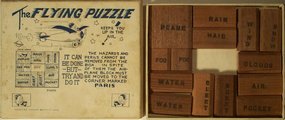
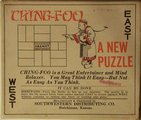
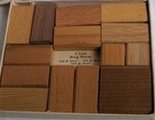
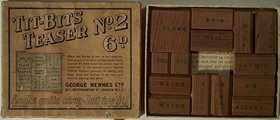
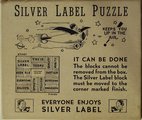
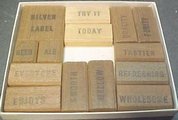
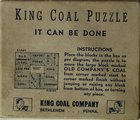
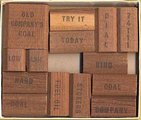
C56, 57 The Flying Puzzle, Ching Foo, Tit-Bits Teaser #2, Silver Label, King Coal These use a 6x5 tray. U.S. Patent 1663568 1663568 - Schneider 1928 Move the plane to the bottom right corner - 55 moves. |
||||||||||||||||||||||||
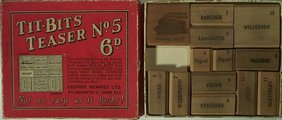
C58 Tit-Bits Teaser #5 aka The Train Puzzle uses a second 2x2 square piece |
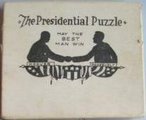
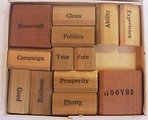
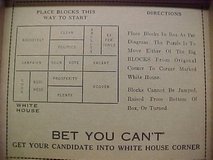
C60, 61 The Presidential Puzzle Listed as and identical to the Century of Progress Puzzle. Move either large square (your candidate) to the lower left corner (the White House). |
|||||||||||||||||||||||
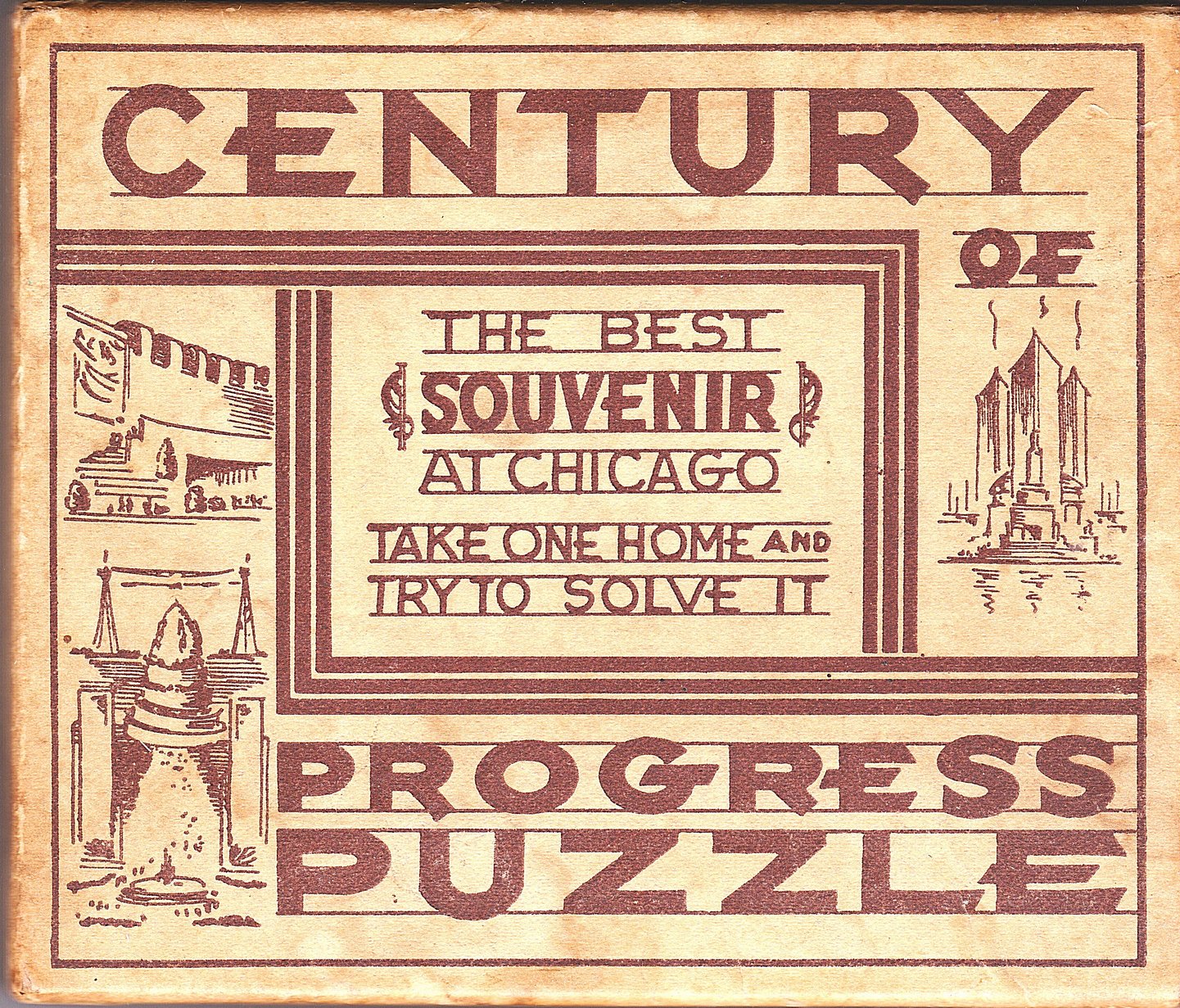
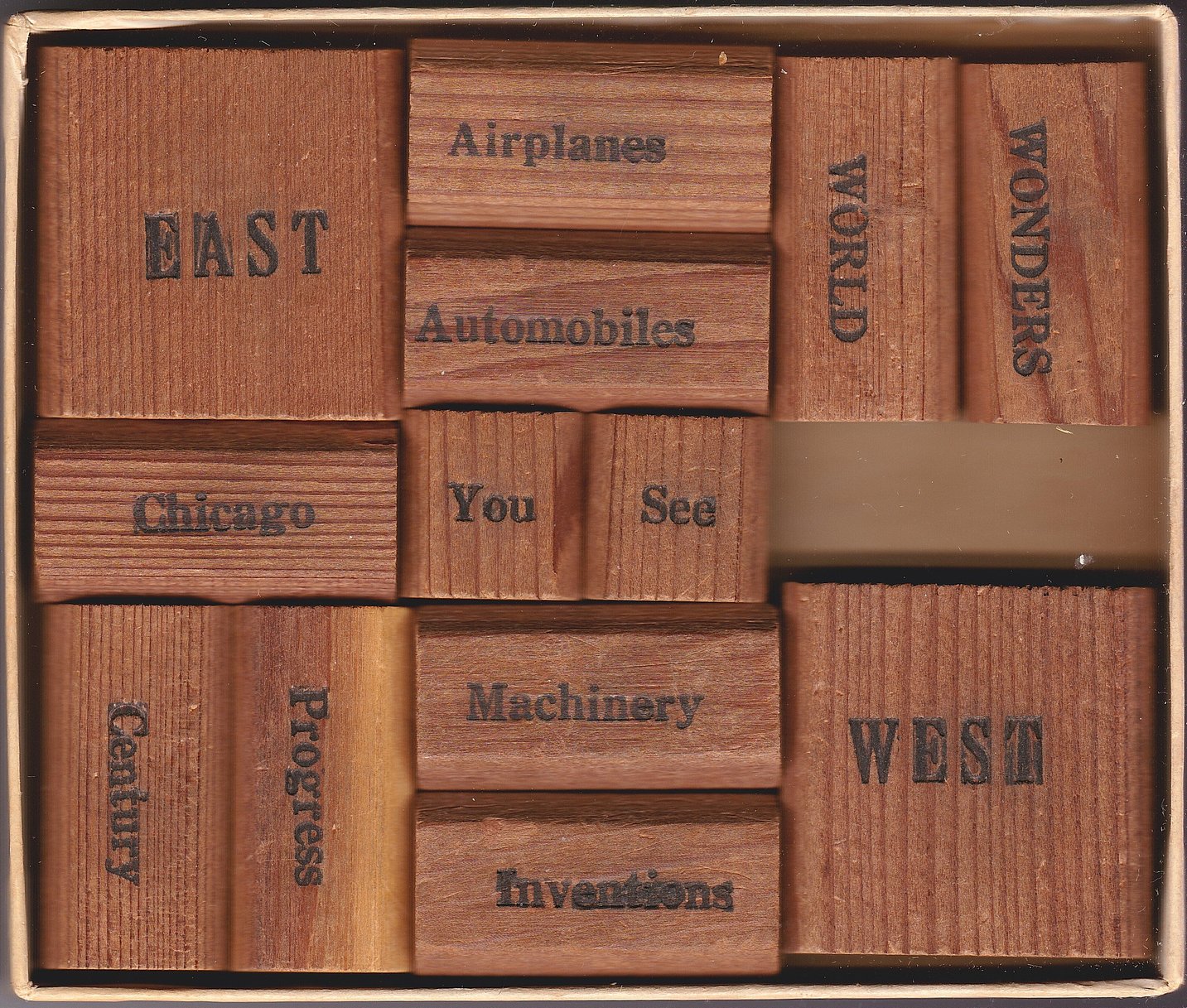
Century of Progress Puzzle - a vintage sliding piece puzzle, issued at the 1933 World's Fair in Chicago. Start as shown, move either the "East" or "West" block to the lower left corner. In Hordern, as C60 (37 moves) and C61 (42 moves) respectively. |
||||||||||||||||||||||||
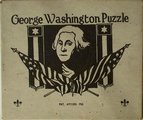
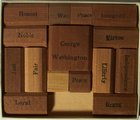
C67 George Washington Puzzle |
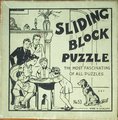
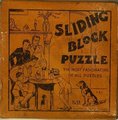
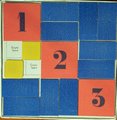
C72,73 The Sliding Block Puzzle by S.S. Adams Play online at Nick Baxter's site. |
|||||||||||||||||||||||
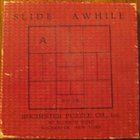
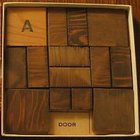
C74,75 Slide Awhile Rochester Puzzle Co. Listed as Model Garage/Spot Check/The Blockade Puzzle Move A to the bottom center. (I don't have this.) |
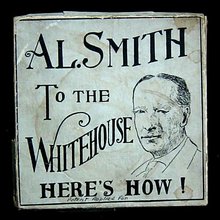
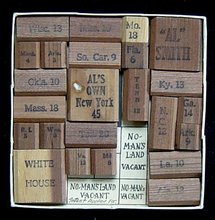
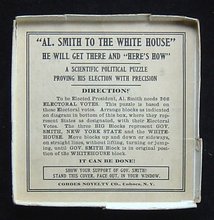
Al Smith to the White House (1928?) Read some biographical material about Al Smith at www.nps.gov. |
|||||||||||||||||||||||
Two sliding-piece puzzles from Popular Playthings -
Sink or Swim, and Outta Gas:
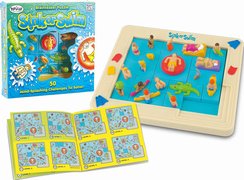
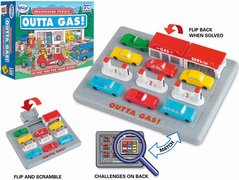
|

A sliding piece puzzle by Pussycat picturing some elephants and featuring a couple of 1x2 pieces to complicate things. |
|||||||||||||||||||||||
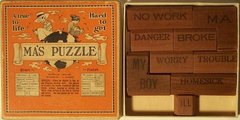 D1,2,3 Ma's Puzzle U.S. Patent 1633397 1633397 - Diamond 1927 Play online at janko.at or Nick Baxter's site. |
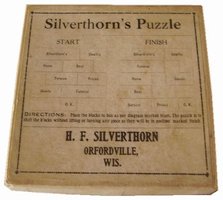
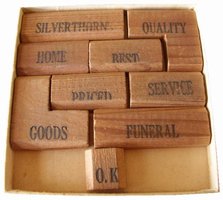
A vintage sliding piece puzzle advertising Silverthorn's of Orfordville, Wisconsin. This is an instance of the classic design Ma's Puzzle, and while the related Dad's Puzzle has been used extensively for advertising, this is the first time I have seen Ma's puzzle used. |
|
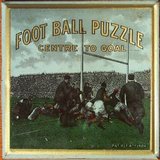
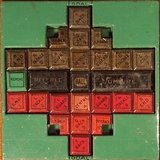
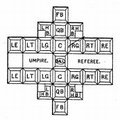 D5 The Football Puzzle See U.S. Patent 771514 771514 - Wehner 1904 Move the ball piece from the center to either top or bottom center. |
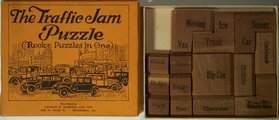 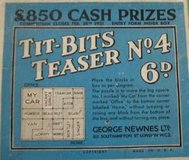
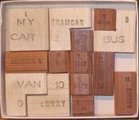 D12-D23 The Traffic Jam Puzzle U.S. Patent 1683014 1683014 - Babcock 1928 aka Tit-Bits Teaser No. 4 Play online at janko.at or Nick Baxter's site. |
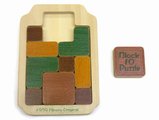 D24-D43 Block 10 - Minoru Abe D24-D49 are designs by Minoru Abe. Try some at Nick Baxter's site. |
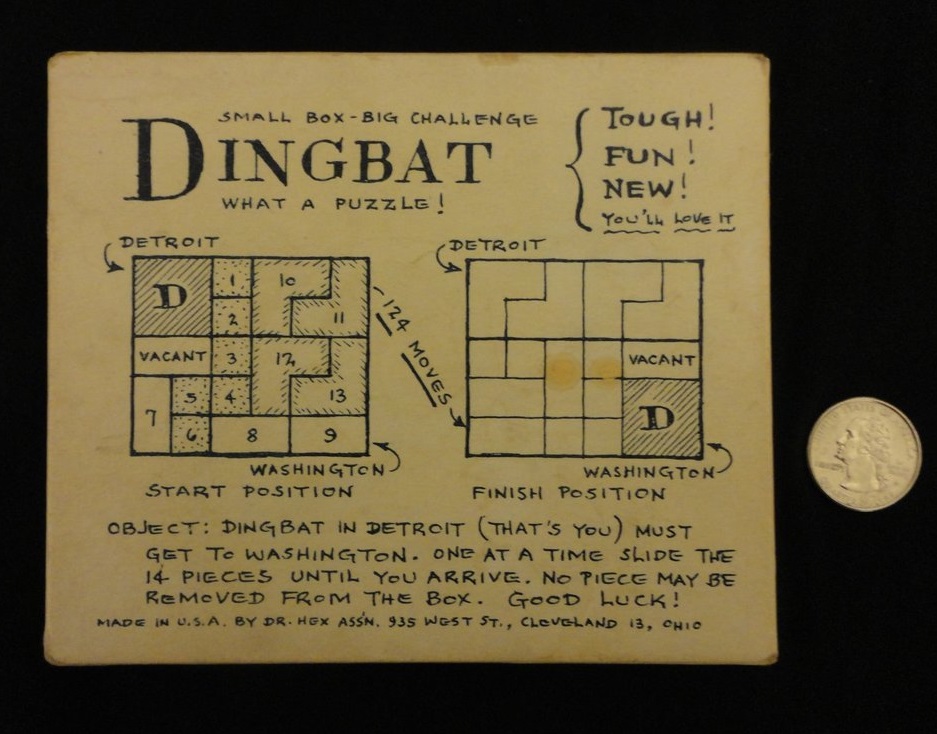
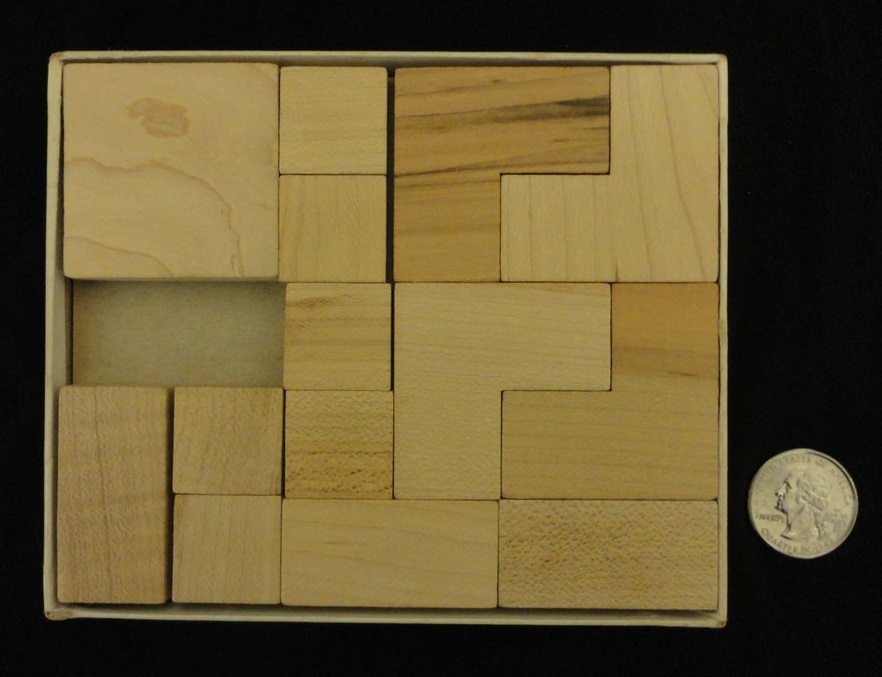
A vintage Dingbat sliding piece puzzle |
||
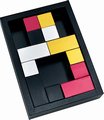 This is The Slider Puzzle designed by Serhiy Grabarchuk and sold by Bits and Pieces. It is not in Hordern's book. Play online at Nick Baxter's site. |
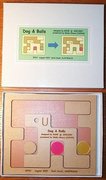 "Dog & Balls" (IPP27) designed by "Mine" (Mineyuki Uyematsu). |
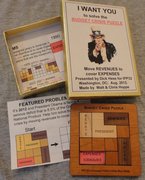 Budget Crisis, designed by Dick Hess and Neil Bickford, made by Laser Lynne, exchanged at IPP32 by Dick Hess |
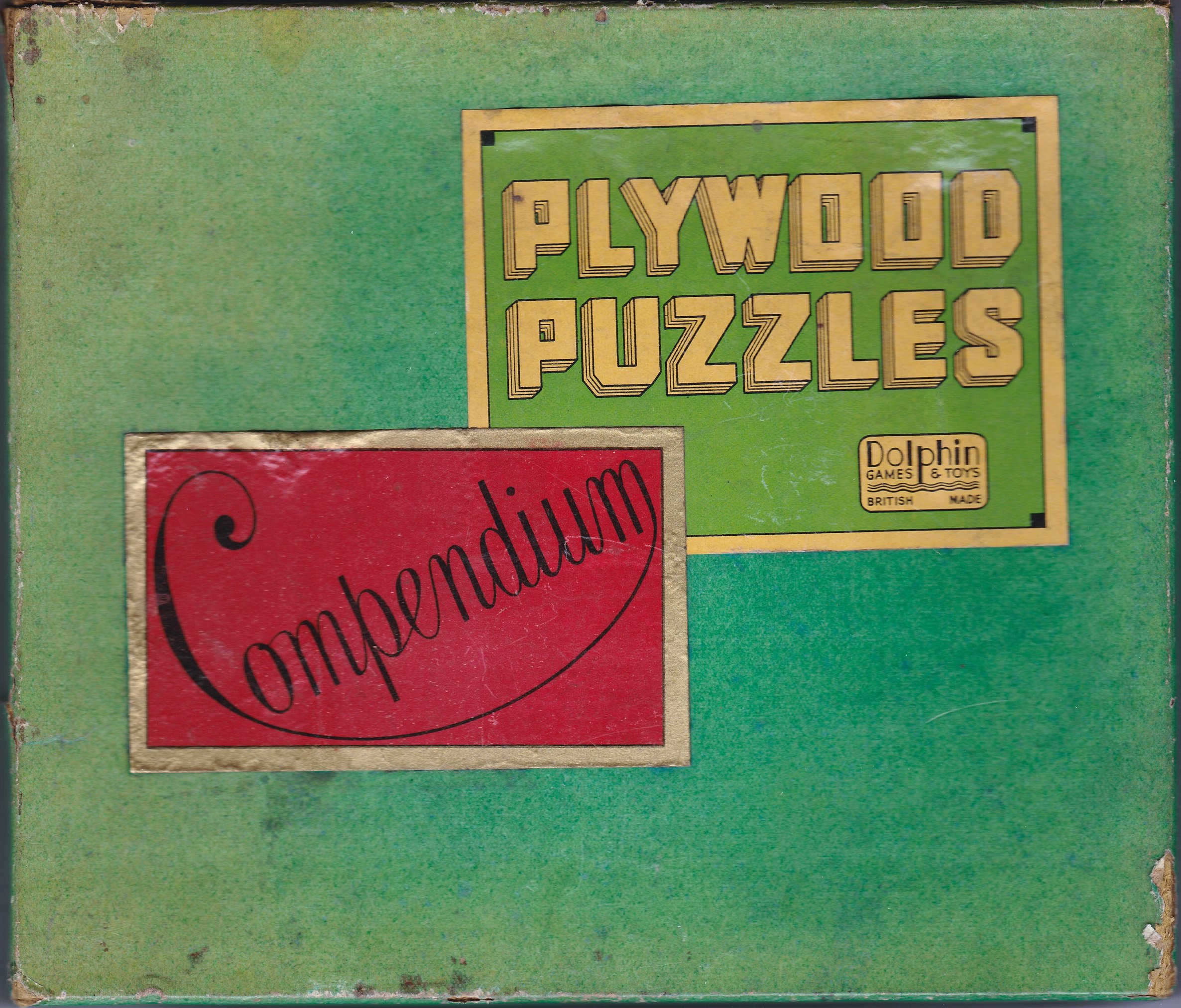
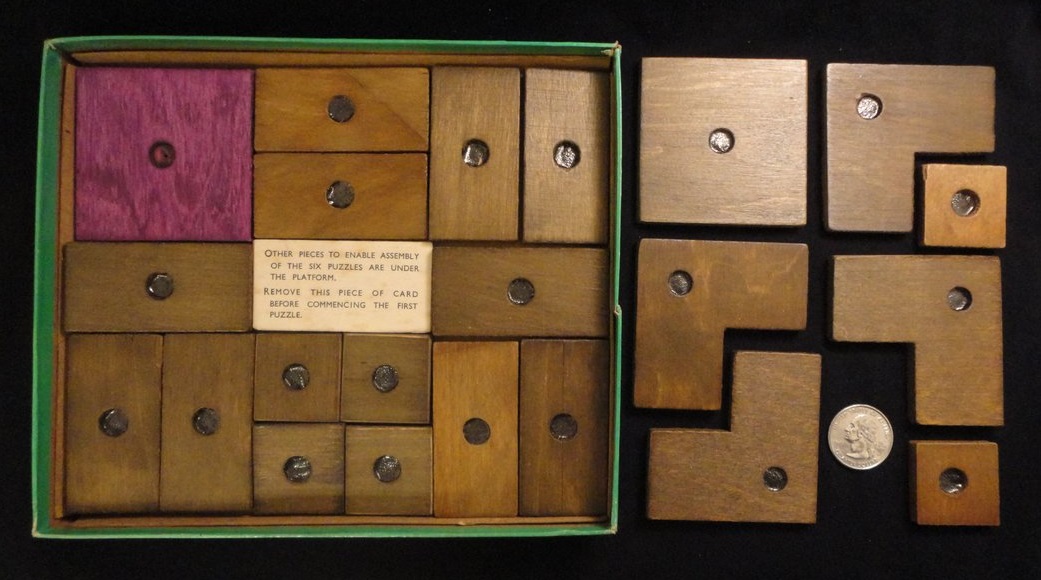
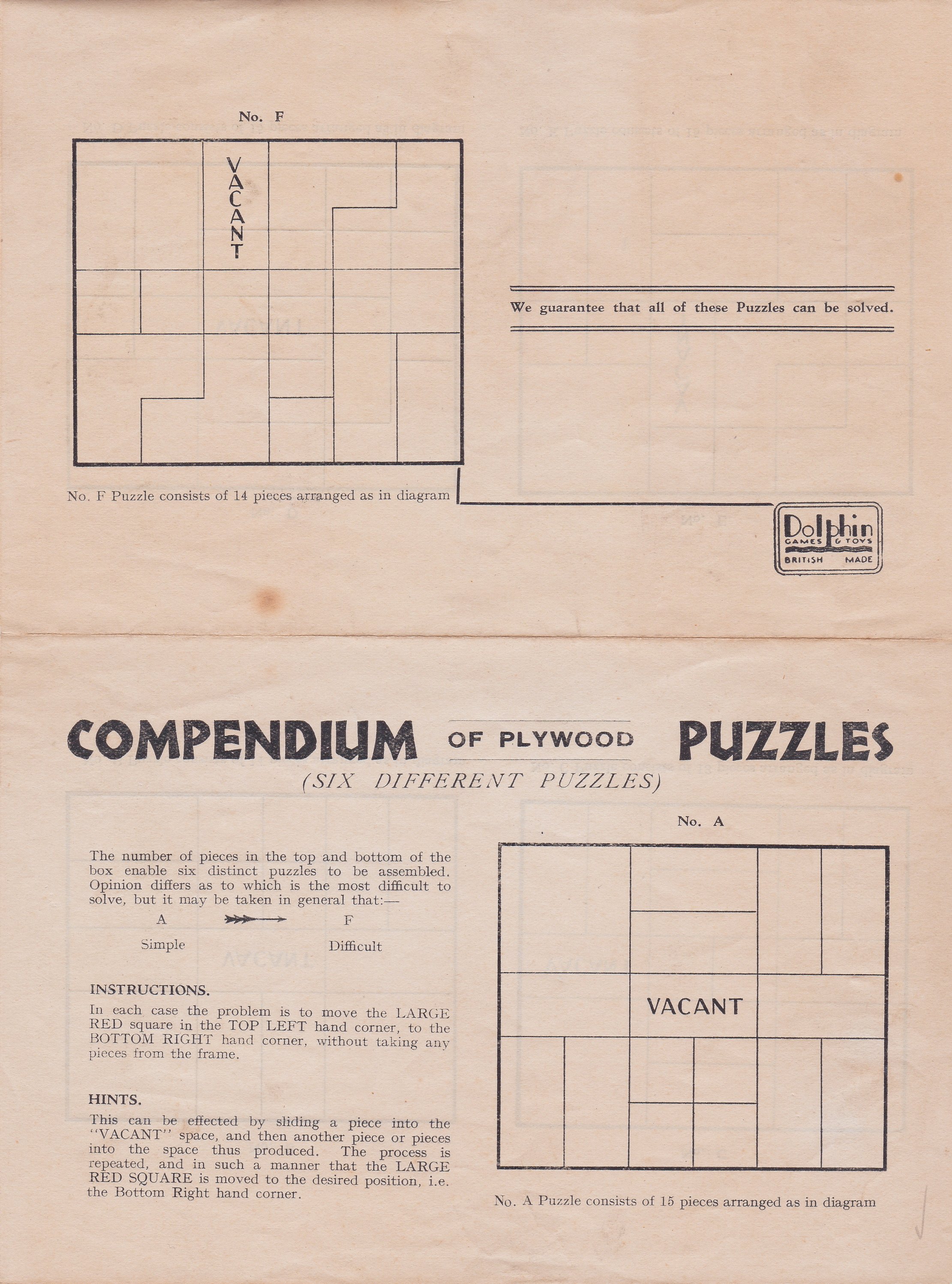
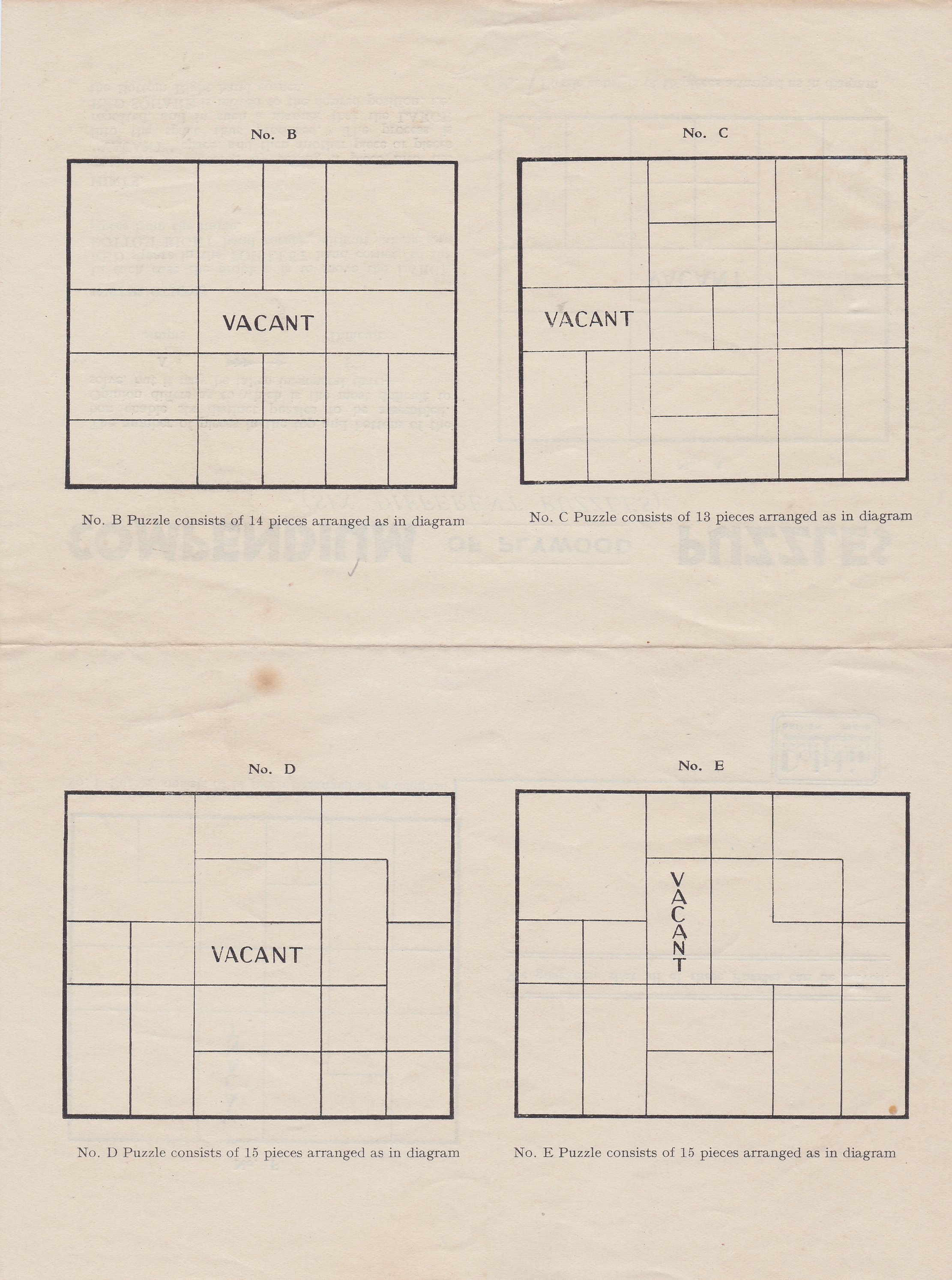
Plywood Puzzles Compendium - a vintage kit from Dolphin Games & Toys of Britain - including pieces to try six different sliding block puzzles A-F. Appears in Hordern - C55 on p.94 is A (48 moves), C58 on p.95 (aka Tit Bits Teaser No.5 or the Train Puzzle) is equivalent to C (59 moves), C59 on p.96 is B (61 moves), D9 on p.109 is F (63 moves), D10 on p.110 is E (76 moves). Hordern omits D. Slocum dates this to 1890! It is feasible, since plywood was introduced prior to 1865, and the cardboard box in 1890. |
||
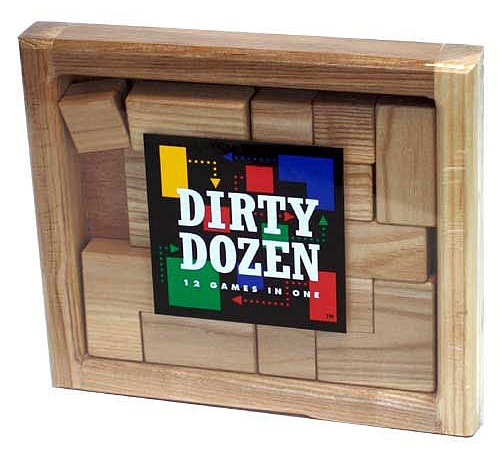
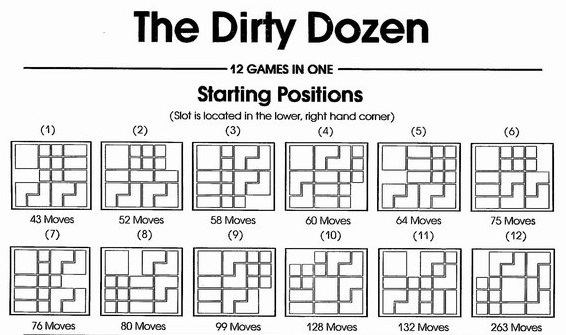
The Dirty Dozen - a versatile sliding piece puzzle by Square Root. Twelve different challenges using the large wooden pieces and tray. |
||
Among the promotions associated with Tit-Bits magazine were a series of puzzles called "Tit-Bits Teasers."
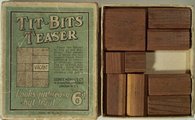 Tit-Bits Teaser No. 1 (1927) C19 This is equivalent to the Pennant Puzzle, or Dad's Puzzle. |

Tit-Bits Teaser No. 2 (1928) C56,57 This is equivalent to Ching Foo and the Flying Puzzle. |
???
Tit-Bits Teaser No. 3 (1929?) (I don't have this.) |
||||||||||||||||||||||||||||||||||

 Tit-Bits Teaser No. 4 (1930) D22 This is equivalent to the Traffic Jam Puzzle. |
 Tit-Bits Teaser No. 5 (1931) C58 aka The Train Puzzle |
B13 A variant of the 15 Puzzle. Start with the first arrangement, remove the 16, and slide the blocks to get to the second arrangement. |
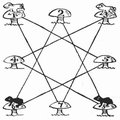 E2 The Four Frogs (aka Four Knights) I don't have it. This puzzle is a sliding version of a chess variant problem: on a 3x3 board, start with two white knights at the north-east and north-west squares and two black knights at the south-east and south-west squares. Exchange the black and white knights in seven legal knight's moves. Note that the center square is never used. |
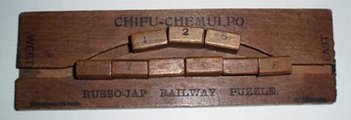  E7 Chifu-Chemulpo |
|
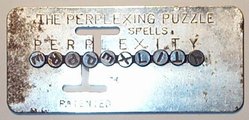 E10 Perplexity Several variations on this design exist. See U.S. Patent 642374 642374 - Shaffer 1900. |
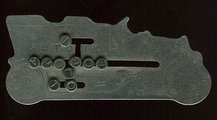 E11 Automobile |
 THINK OF JONAH |
 1904 Louisiana Purchase Expo |
 1915 Panama Canal Expo |
 The Panama puzzle, from 1915. Not in Hordern. Start at the left end of the puzzle - put the three A's in slots 1, 2, and 3, and the other letters in slots 4, 5, and 6. In three moves exactly, moving two at a time that are adjacent and keeping them adjacent, spell PANAMA with no embedded spaces. |
 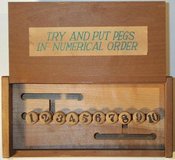 Shackman Famous Number Puzzle |
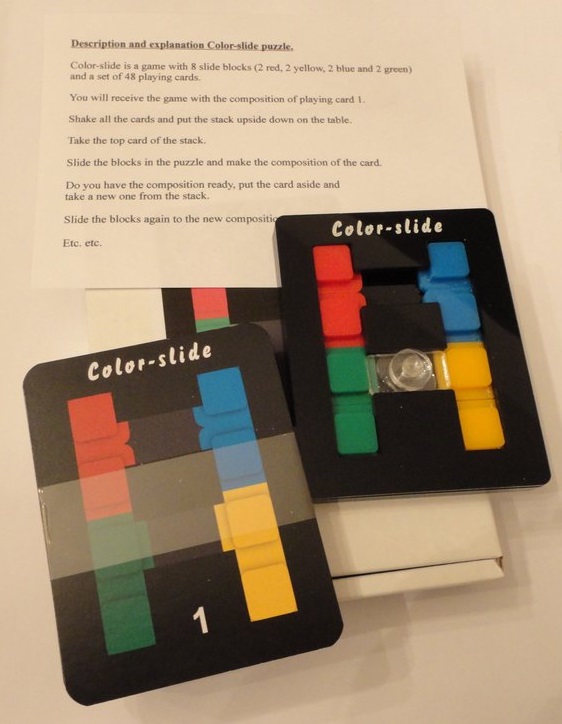
Color Slide - Hans van der Zanden IPP34 Eight sliding squares, 2 each of four colors, riding in a two-rung ladder track. 48 cards specifying target patterns. Draw a random card and slide the pieces from whatever the current configuration is to the target pattern. |
|
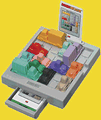

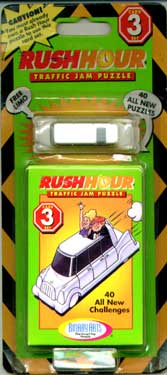
 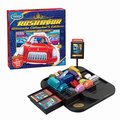
E15 through E18 clearly presage what has become one of the best-selling puzzles of modern times; Binary Arts' Rush Hour. Move a specific vehicle out the lone exit in the border, first figuring out a way to clear the path of obstructing vehicles. A deck of cards gives progressively harder problems to set up and try. There are several expansion packs with new cards and a vehicle. |
E19 Pink and Blue by Nob Yoshigahara 1982 I don't have it or a photo. Play online at Nick Baxter's site. Play other Nob puzzles at Nick Baxter's site. |
|
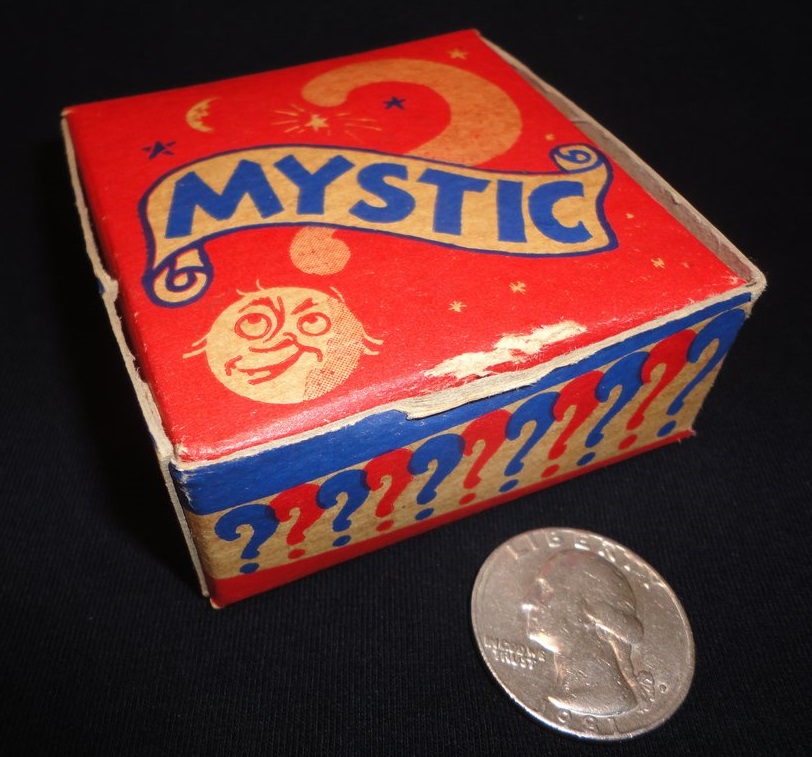
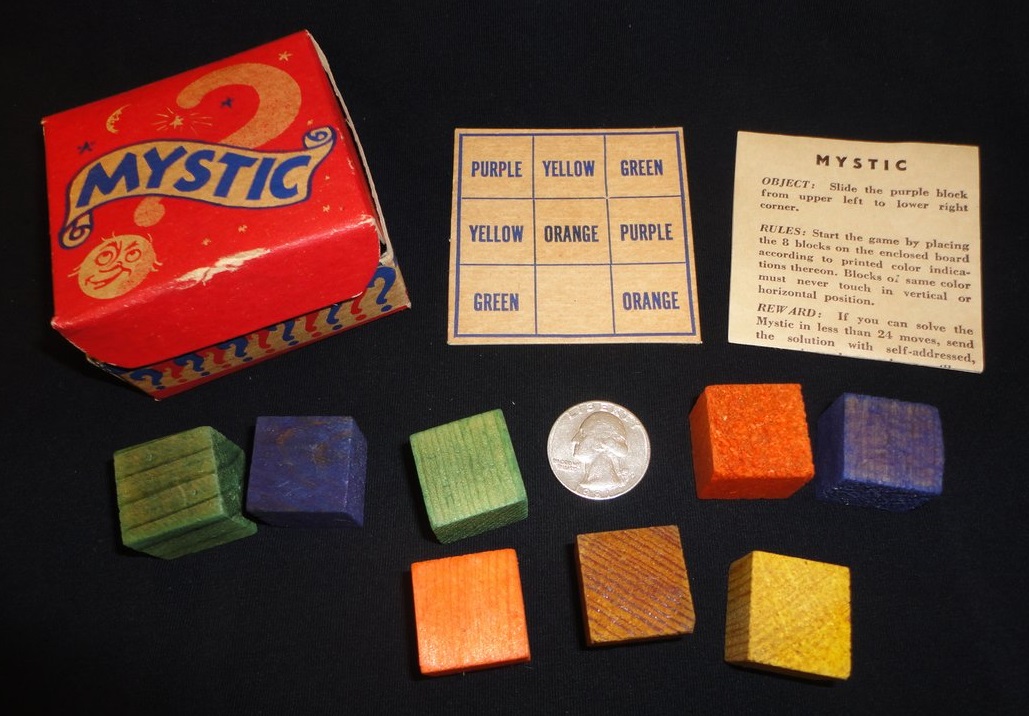
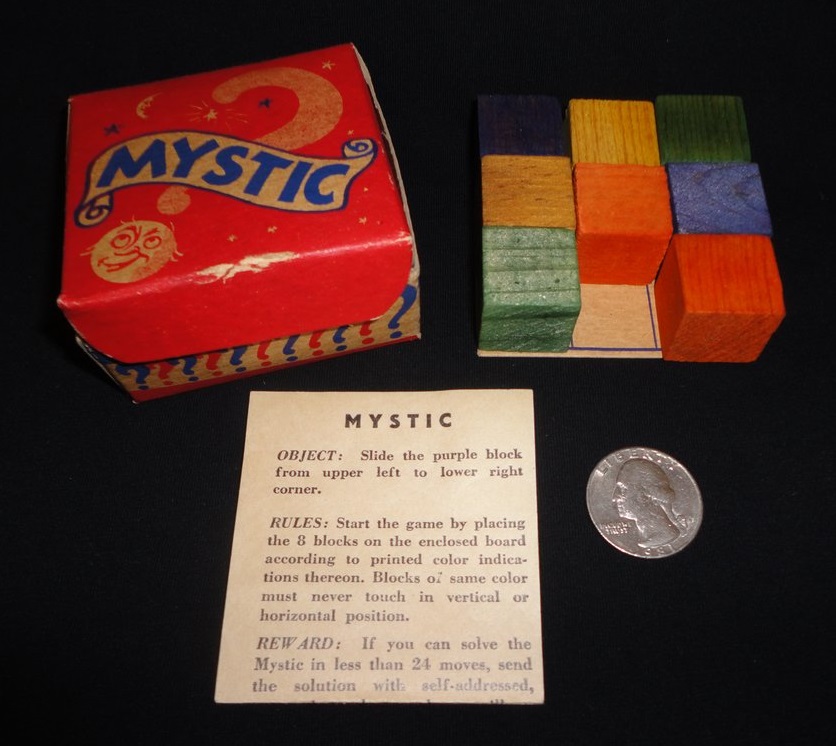
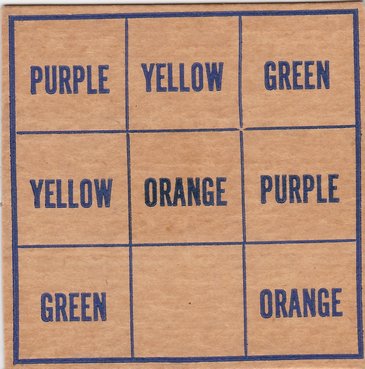
 E24
E24Mystic Richard Appel Inc. USA 1943 Move the purple piece at the top left corner to the bottom right corner - but pieces of the same color may not ever touch sides. Hordern says this can be done in 22 moves. |
||
 E29 Fox and Geese I don't have it or a photo. Start with three white pieces (geese) on 1,2,3 and three black pieces (foxes) on 10,11,12. Exchange the black and white pieces moving only along lines and stopping only on circles. At no time except in passing can a fox and goose be at opposite ends of any line. |
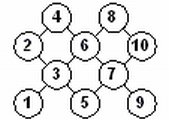 E30 A New Counter Puzzle From Amusements in Mathematics H. Dudeney 1917 I don't have it or a photo. Start with white pieces on 1 and 2 and black pieces on 9 and 10. Exchange them moving only along lines and stopping on numbered spots. At no time except in passing can a black and white be on the same straight line. |
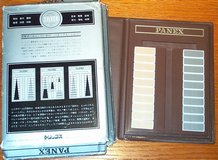 E35 Panex Discussed by Manasse, Sleator, Wei, Baxter in Tribute to a Mathemagician 2005 - see Baxter's page devoted to Panex. Key distinction from Towers of Hanoi: pieces will not descend below their appointed height in stack - 10-high stacks require 31,537 moves (verified by Derek Kisman, who developed an efficient search algorithm). Play Panex online here, or a simplified version at Cheesygames. Kisman also found that the shortest solution for level 11 is 76,245 moves; level 12 is 184,191; and level 13 is 444,807. |
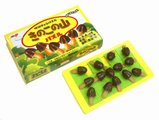
Kinokonoyama The pieces interfere with some of their neighbors, preventing some movements. |
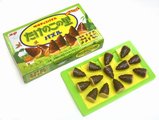
Takenokonosato The pieces interfere with some of their neighbors, preventing some movements. |
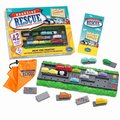
Roadside Rescue - Thinkfun |
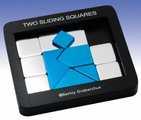
Two Sliding Squares - Grabarchuk - from Bits & Pieces. The blue parts are attached to the tops of some of the silver pieces, and overhang some piece edges. Slide the pieces to form a large square with the blue parts. (This combines a sliding piece puzzle with a well-known square dissection.) |
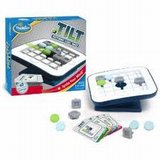
Tilt invented by Vesa Timonen and Timo Jokitalo Tilt the board to slide green, but not the blue, pieces into the central hole. Every move must move all pieces in the tilt direction as far as each can go unobstructed. Fun! |
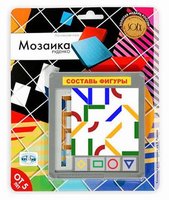
Rudenko Mosaic |
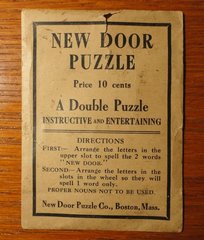
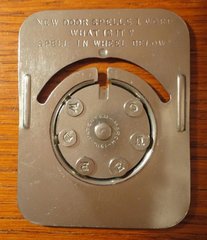
The New Door Puzzle Slide the buttons using the central carousel, to transform the letters of "NEW DOOR" into 1 word. A nice metal implementation of a well-known anagram puzzle. SPOILER ALERT: See U.S. Patent 1132430 issued to Brogan and Bruner on March 16, 1915. My copy is missing one of the buttons (one of the 'O's). |
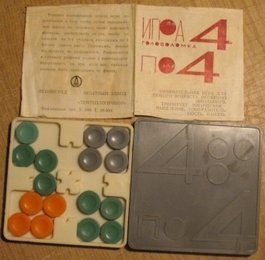
Russian 4x4 puzzle |
|
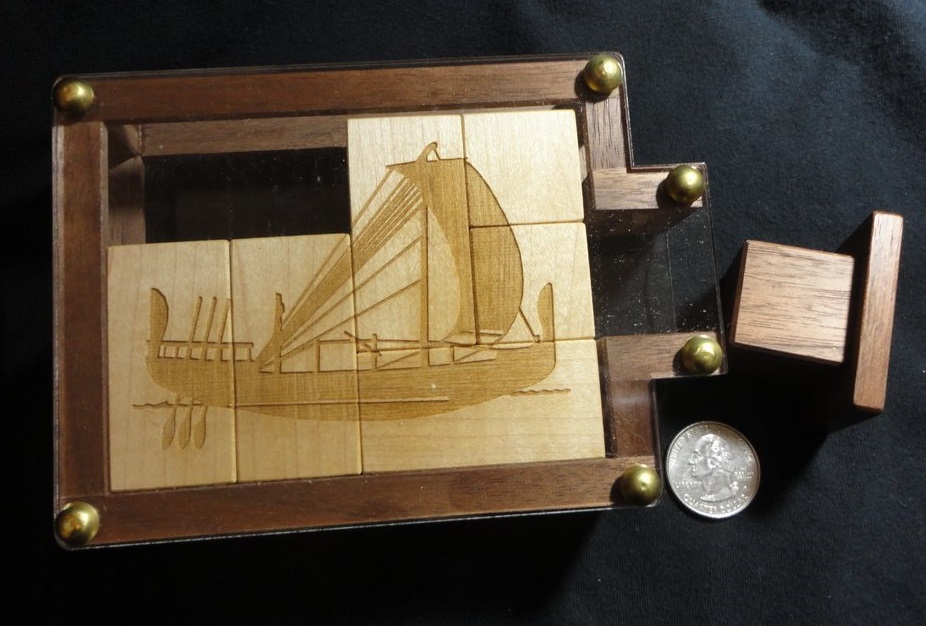
Ship in a Bottle - designed by Goh Pit Khiam, made by Tom Lensch Get the pieces out, then reinsert them so the ship faces the other way. |
||
| A while back there was a computer game called "The Seventh Guest" and a sequel called "The Eleventh Hour." Both were puzzle-based "adventure" games with a horror/suspense flavor. The Eleventh Hour contained a version of a classic puzzle challenge known by various names including the "Crazy Knights" and "Knights Exchange." Adventure games have contained many logic puzzles that yield to mathematical analysis. Arabesk (defunct) offered this version of Crazy Knights. (I don't have it.) The Knights Exchange is played on the irregular fragment of a chessboard shown here. For discussion, I have numbered the squares. The initial condition of the puzzle has white knights on squares 6 and 10, and black knights on 1 and 3, and your task is to interchange their positions using only legal knight's moves. This can be done in 40 moves. |
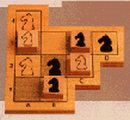
+----+ | 1 | +----+----+----+----+ | 2 | 5 | 8 | 10 | +----+----+----+----+ | 3 | 6 | 9 | +----+----+----+ | 4 | 7 | +----+----+ |
|
To solve this puzzle, consider that it might be easier to analyze if you were able to look at it in a different (although isomorphic) way. Starting with the square designated 1, construct a graph where each node represents a square, and each edge between nodes represents a (reversible) knight's move between the corresponding squares. Arrange the graph as a simple unbalanced binary tree with 1 as the root. Using the graph, you'll note that movement has been conceptually simplified, making the whole puzzle easier to comprehend and attack. Rather than hard-to-visualize knight's moves on the irregular chessboard fragment, you're now dealing with simple moves from node to node along the edges of a straightforward tree. We've "reduced" the problem to a Perplexity-type puzzle - you can think of the nodes 10 through 5 as a straight track, having a single side branch or "parking space" at 3. You've got 2 white pieces and two black pieces and you've got to shuffle them past each other exploiting the single parking space at 3. |
(1)
/ \
(6) (8)
/ / \
(10) (3) (7)
/
(2)
/
(9)
/
(4)
/
(5)
|
|
You may wish to attempt to deduce a winning sequence yourself now that you have a better representation of the puzzle with which to work (read on at the risk of spoiling whatever remains of the puzzle). Here is a sequence of moves which accomplish the task. 'B' represents a black knight; 'W' a white knight. B@n means a black knight at square number 'n'. Two numbers separated by commas mean move whatever is on the square designated by the left hand number to the square designated by the right hand number. If you count the commas (which are moves) you'll see there are 40. Also, note that we didn't need squares 4 and 5 at all. To solve this puzzle, I've employed a strategy common in mathematics and operations research - when faced with a problem, try to find an isomorphism with another type of problem for which a solution can be more easily found. I'll readily admit that this strategy cannot be used on every puzzle, but I thought this was a great example. |
B@1,8,7,2,9 W@6,1,8,7,2 W@10,6,1,8,7 B@3,8,1,6,10 W@7,8,1,6 W@2,7,8,1 B@9,2,7,8,3 W@1,8,7,2 W@6,1,8,7 B@3,8,1,6 W@7,8,3 W@2,7,8,1 |
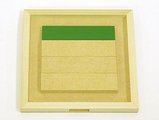
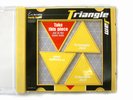
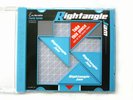
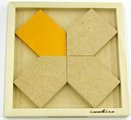
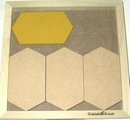
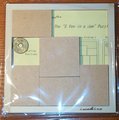 Here is an interesting series designed by
Hirokazu Iwasawa aka "Iwahiro."
Here is an interesting series designed by
Hirokazu Iwasawa aka "Iwahiro."
Rectangular Jam, Triangle Jam, Rightangle Jam, Pentangular Jam, Hexangular Jam, and 5 Yen in a Jam (IPP28) Get the highlighted block out through a slot in the south wall. Unusual because you may rotate the pieces flat in the tray. |
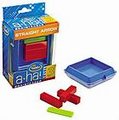
Straight Arrow, from Thinkfun, is a nice, portable, inexpensive copy of Iwahiro's Rectangular Jam. |
|
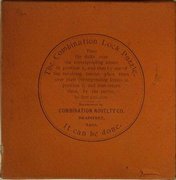
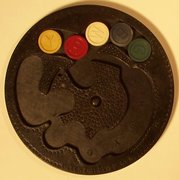 F13 The Combination Lock Mfd. by the Combination Novelty Co. See U.S. Patent 560197 560197 - Dow 1896. |
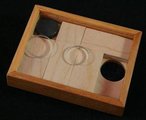 Drop Out Designed by Stewart Coffin (#202) IPP27 exchange puzzle of Henry Strout Four 1x2 blocks and one 1x1 block are contained in a 3x4 tray with a transparent cover which has a hole in one end - the bottom of the tray has a hole in the other end. Drop in a magnetic disk then by shifting pieces, get it out the opposite hole. Requires 26 moves. If the disk is dropped in again with the blocks as positioned after the solve, there is no solution! It takes 8 moves to restore the blocks to a solvable state. |
|
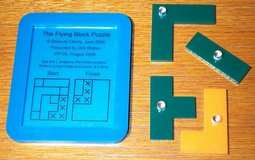 The Flying Block (or Jumping Block) puzzle designed by Dries de Clercq. A gift from Dirk Weber at IPP28 in Prague. Thanks again, Dirk! Sliding, jumping, and rotation of pieces are allowed, but only one piece at a time. Mr. Puzzle Australia produced one. |
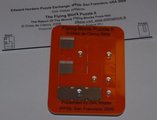
Flying Block II IPP 29 in SF |
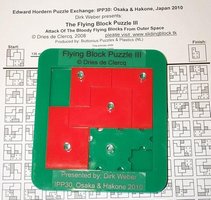
Flying Block III IPP30 |
|
David at Eureka recommended the Dig It! puzzle produced by
Foxmind.
It is designed by Alex Polonsky. There are 50 challenges in four increasing levels of difficulty. In each, you must move a set of pieces in succession until a "bone" piece is fully revealed. 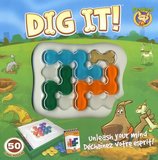
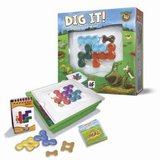
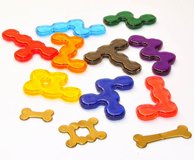 This reminds me of de Clercq's Flying Block puzzles.
This reminds me of de Clercq's Flying Block puzzles.
|
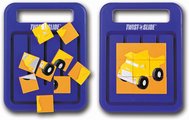 Twist-'N'-Slide Truck |
|
This section contains sliding piece puzzles having unusual features.
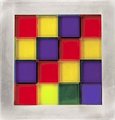 This is an interesting version of the sliding block theme called Color Magic. I bought it at Games People Play. It is from the Metropolitan Museum of Art. Begin with primary colors. Slide the fifteen tinted translucent tiles in order to produce the secondary colors. The color of a tile combines with the color of the square printed beneath it on the base. |
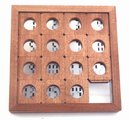 Janus - by Frank Potts (I don't have this.) The idea here is to solve a kind of 15 puzzle, but the twist is that each number is represented in stylized segmented form and has been decomposed into two sets of segments, each of which is on a separate transparent layer. Essentially you need to solve two 15 puzzles simultaneously so that the transparent tiles combine properly to re-form the numbers in order. Some thought went into how to best decompose the numbers into two separate layers, to allow one proper solution. Another twist is to present a 15-14 version that can be solved with a parity trick. Frank says he made only two to enter in the IPP 2005 design competition - the photo is from the design competition page on John Rausch's site. Play Janus online at Frank's website. |
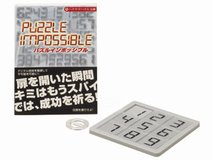
Puzzle Impossible, from Hanayama. This is an unusual sliding piece puzzle - marks on the transparent pieces combine with marks on the tray to form digits. Purchased at Eureka. |
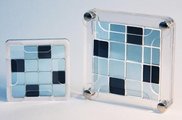
The Svetnashki is a sliding piece puzzle design from Russia, based on polarized light - It comes in two sizes: 7 cm. and 10 cm. |
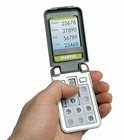
SmartPhone Produced by Smart Games, designed by Raf Peeters. |
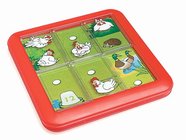
Chicken Shuffle Produced by Smart Games, designed by Raf Peeters. |
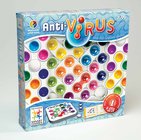
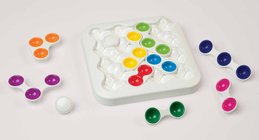
Anti-Virus Produced by Smart Games, Anti Virus is the production edition of Bulbous Blob designed by Oskar van Deventer and James W. Stephens - you can see it and play a few levels at the Puzzlebeast website. It's like a crab-wise variant of Rush Hour, but with a nice added level of complexity due to the richer movement possibilities. |
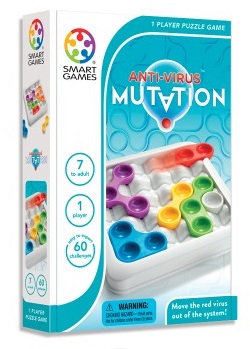
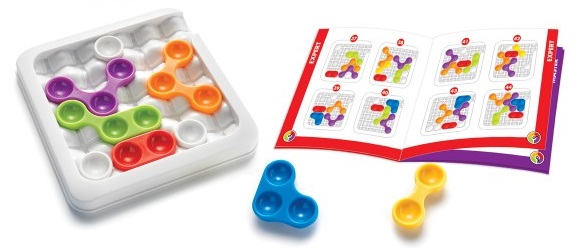
Antivirus Mutation - SmartGames |
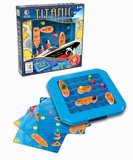
Titanic Produced by Smart Games, designed by Raf Peeters. Also similar to Rush Hour. A very slick design - the problem initial position card is visible when you look straight down through the "water." A set of passengers need to be rescued by a set of lifeboats, which can move forward, backwards, or sideways unless blocked. Passengers scramble into free seats as soon as possible. A full boat must remain stationary (and therefore impedes the movement of other boats). |
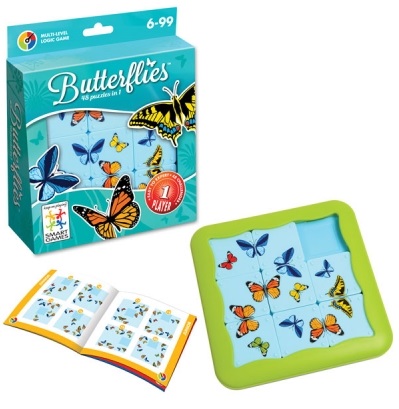
Butterflies - issued by SmartGames 48 challenges (starting positions) - slide until all butterflies are whole. |
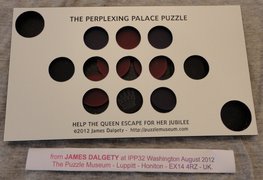 Perplexing Palace, designed, made, and exchanged at IPP32 by James Dalgety |
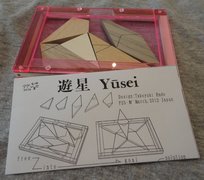 Yusei, designed, made, and exchanged at IPP32 by Takeyuki Endo Slide the pieces in the frame to form a star. The top point of the star can stick out of the frame. |
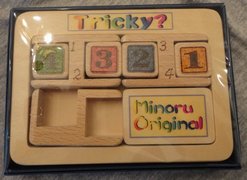
Minoru Abe's Tricky? |
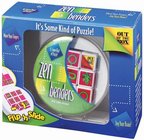
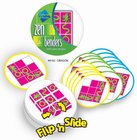
Zen Benders Dragon |
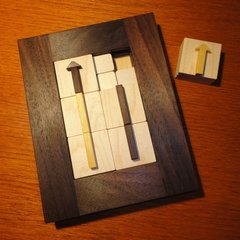
Arrow Blocks - designed by Goh Pit Khiam, made by Tom Lensch. The frame is Indian Rosewood. The pieces are Maple and the arrows are Yellowheart and Brazilian Blackwood. A nice substantial size - the tray is 7" x 5.5" x 1" thick. The pieces are 1.5" squares. Entered in the 2012 IPP Design Competition. Tom's creations are always a joy to behold and to play with, and this is no exception. And this design from Goh Pit Khiam is no less tricky than his others. Named one of the top puzzle finds of 2012 at a recent gathering of puzzlers. Only six blocks - all distinct - each showing part of a yellow or brown arrow, and each having various internal flanges that interact both with other pieces as well as the inside of the tray walls. Starting with the pieces in the position shown, restore both arrows. A sequential movement puzzle that appears at first glance to be a simple sliding piece problem. However, astute observers will note the internal flanges that are blocking the last piece, the yellow arrowhead, from being placed in the tray. It won't be as easy as it might seem! Employing internal flange concepts similar to the Tom's Square Dance and "Little Window" from Tom Jolly. |
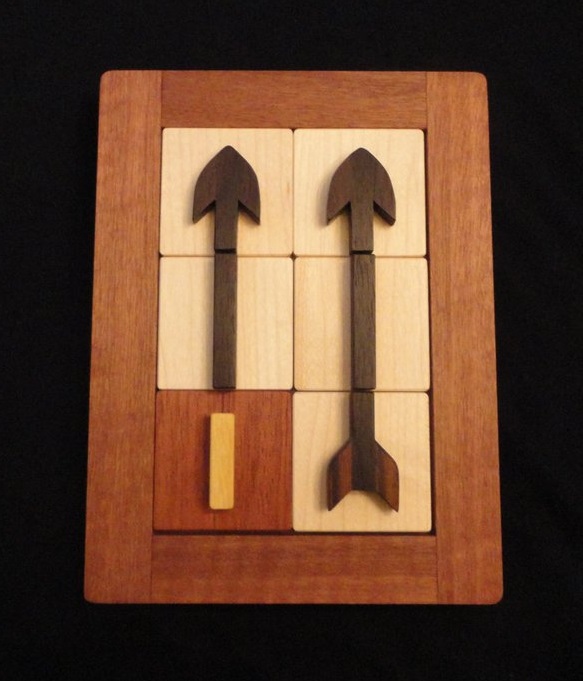
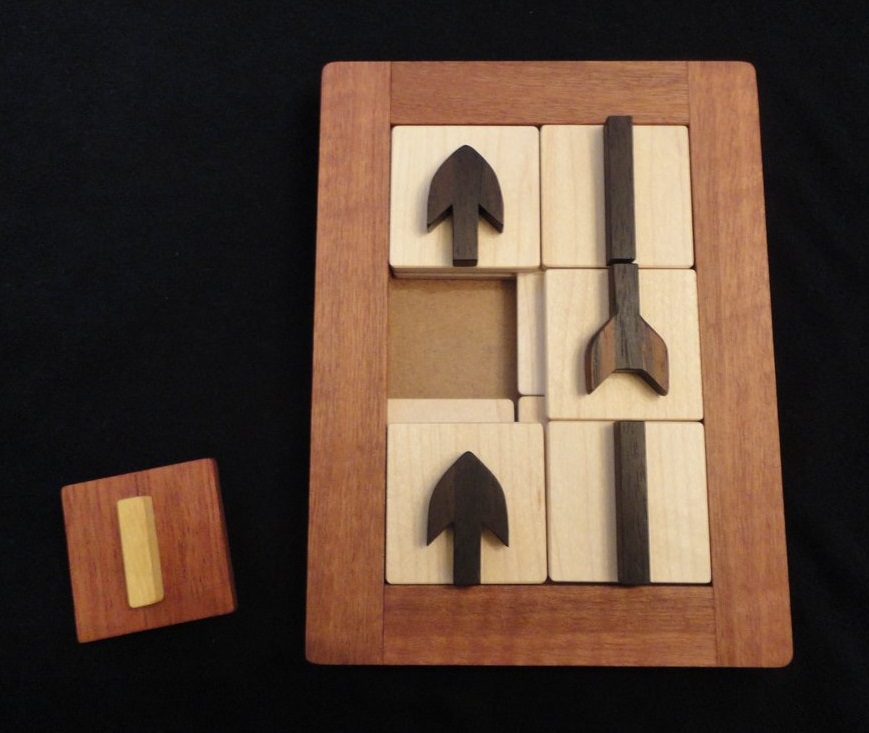
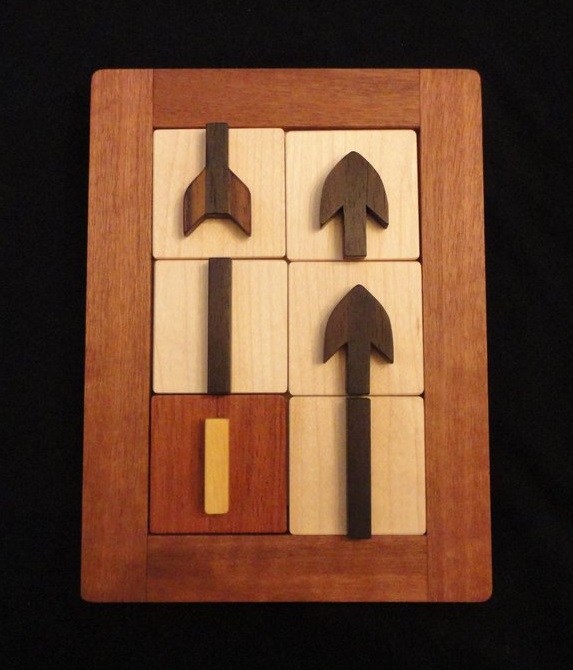
Slide Blocked Sliding Block - designed by Bill Cutler, made by Tom Lensch. Winner of the 1988 Hikimi Wooden Puzzle Competition. Tom has modified the appearance of the pieces to resemble the 2012 IPP Design Competiton Entry Arrow Blocks by Goh Pit Khiam, but this works differently. |
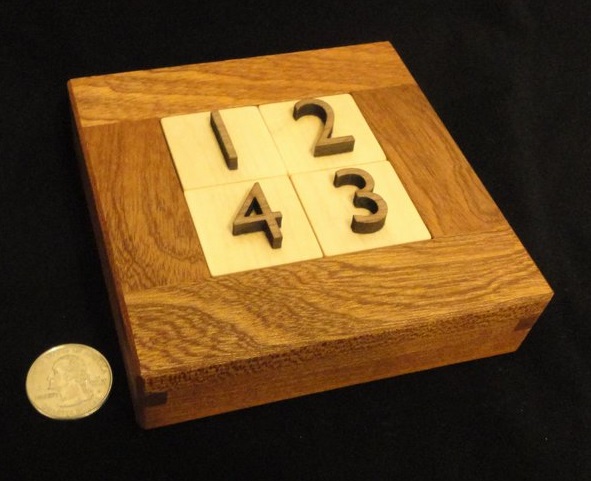
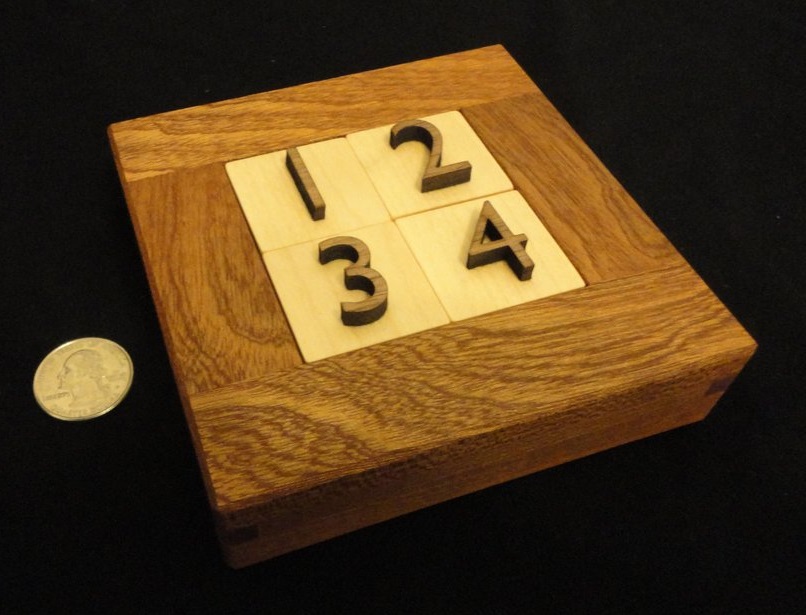
Number Blocks - designed by Goh Pit Khiam and made by Tom Lensch Only four numbered blocks in the frame - move them from the 1243 config shown first to the 1234 goal config shown next. Winner of a Jury Honorable Mention in the IPP35 Design Competition. One of my favorites. A clever design, beautifully made by Tom. |
|
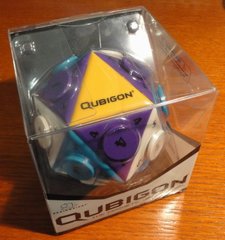
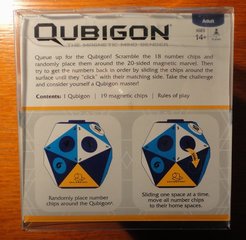
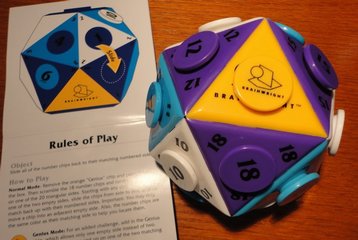
This is Qubigon, a new release from Brainwright. It is a sliding-piece puzzle using magnetic pieces on the surface of an icosahedron. The pieces are numbered 1 through 18 and colored either white, blue, or purple to aid in recognition. Each piece has a correspondingly numbered and colored triangle on the face of the icosahedron. There are also two yellow faces, and one yellow "Genius" piece. The normal puzzle is to remove the yellow marker and scramble all the other pieces around the icosahedron, then by using the two empty faces, slide the pieces to return them to their home faces. The magnetic tiles adhere nicely and slide across the edges from face to face with a satisfying click. For added difficulty, you can add back in the yellow piece and end with it on one of the yellow faces. |
|
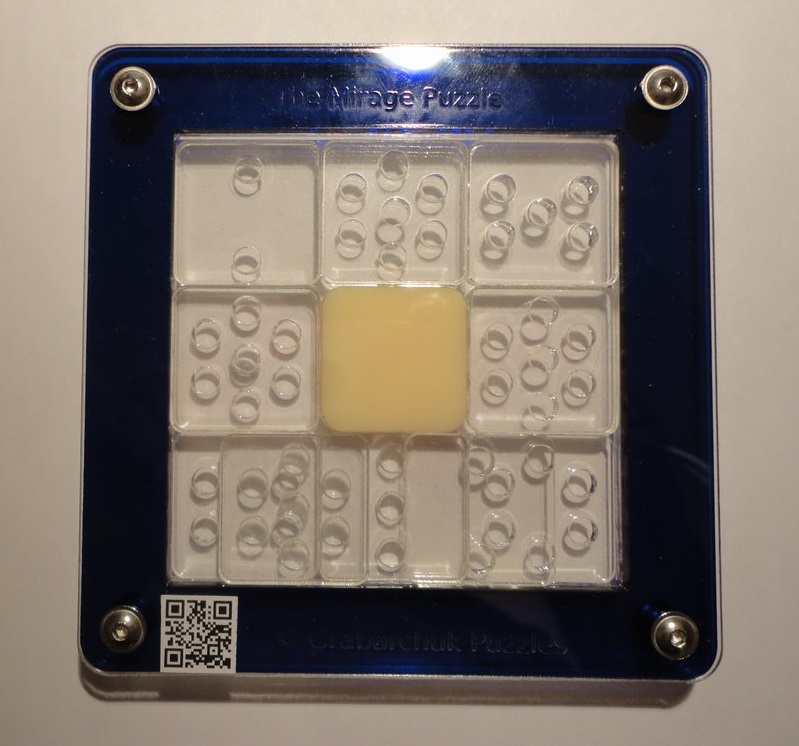
The Mirage Puzzle designed by Serhiy Grabarchuk in 1992 It is described in his book "Neo Sliding Block Puzzles" The acrylic enclosure sandwiches two layers of sliding tiles, a fixed island in the center, and a single-tile single-layer space. Using the space, slide the tiles between start and goal configs described on the website (cw b,1,2,3,4,5,6,7) -> all 7s. |
|
|
I found an interesting sliding piece puzzle crossed with an edgematching puzzle -
a Roalex Numb Skull puzzle on its original card:
|
|
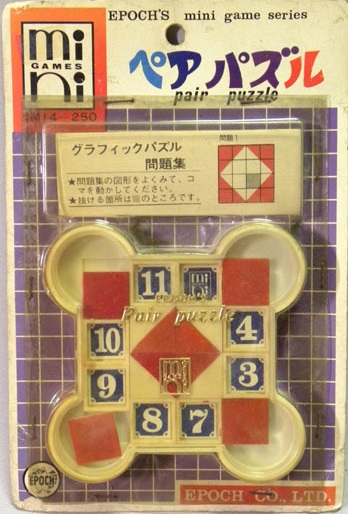
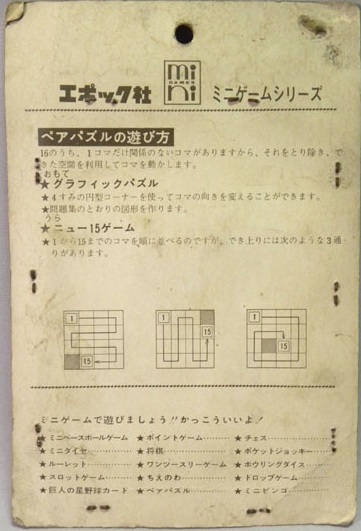
Pair Puzzle - from Epoch's Mini Games series (Japan) A sliding piece type puzzle. |
|
Thinkfun has issued a soko-type puzzle called Treasure Quest:
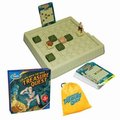
You, too, can search the U.S. Patent database. The CCL for "shifting movement" puzzles of this type is 273/153s. Last time I checked, there were 533 hits spanning many different kinds of puzzles. NOTE: to view the patents at the uspto site, you'll need a TIFF plug-in for your browser. I have added links to Google Patents.
 Pryse Protheroe 1885 332211 332211 Employs a turntable. |
 Arthur G. Farwell 30 Sep. 1890 437186 437186 W.W. Rouse Ball in "Mathematical Recreations and Essays" p.114 (11th Ed. 6th printing 1973, orig. pub. 1892), says he bought a shunting puzzle "some years ago" called the Great Northern Puzzle. The configuration illustrated in the book resembles Farwell's. A similar configuration is shown in the Wagon Works puzzle described on "The Ultimate Puzzle Site: Logical Puzzles." (Warning: Pop-Ups on the main page.) |
 Charles W. Lurtey 9 Dec. 1890 442445 442445 - this looks like the "Engineer's and Switchman's Puzzle" shown below. See also Burger 1933 below. |
 James E. Jackson 1891 449881 449881 - 3 cars in the triangle, loco to the right |
 John Alfred Allen 1892 482957 482957 |
 John M. Rodgers 1901 688339 688339 |
 Frank Lisle Napier 1902 703076 703076 - this is almost certainly the Railroad Pass shown below, by the Napier Mfg. Co. |
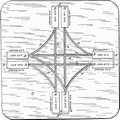 Martin H. Anderson 1903 Street Car Puzzle 729522 729522 |
 Edward S. Mowry 1903 743015 743015 - W.W. Rouse Ball on p.115 calls this the Chifu-Chemulpo Puzzle, on sale in the streets in 1905. The main line can hold only 8 cars and the spur only 4. To start, 8 numbered cars reside on the main line in order and the engine on the spur. The object is to reverse the order of the cars. See the similar "Good Luck" horseshoe-shaped puzzle shown below. |
 Henry Keeler Feb. 1904 750862 750862 |
 Orril L. Hubbard Mar. 1904 753266 753266 - using turntable |
 Livingston B. Pennell Feb 1905 783589 783589 |
 Charles E. Harris Nov 1905 804314 804314 |
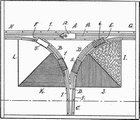 W.E. McGraw & A.M Goodale 1906 822862 822862 - 4 cars in triangle |
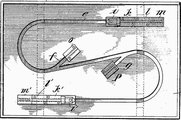 Harry G. Webster 1907 856749 856749 - switch positions on S-shaped track |
 John J. Barnes Dec. 1907 874726 874726 - several puzzles using a comprehensive track layout |
 Solon S. Cahill 1908 878187 878187 - also shown here: Grantham vs. Boston - a simple passing problem with one short siding (aka "blind spur") |
 John W. Clark 1908 898321 898321 |
 Charles M. Conley 1912 1018879 1018879 |
 Thomas F. Young 1916 1174219 1174219 |
 John W. Braunschweiler 1918 1275210 1275210 |
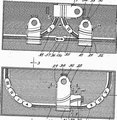 John Vandever Wells 1921 1377039 1377039 - 2 puzzles, unique switches |
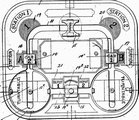 Bruno von Bueltzingsloewen 1925 1560921 1560921 |
 Maximilian E. Pesnel 1928 1673705 1673705 |
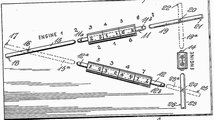 Clarence W. Burger 1933 1920291 1920291 - This looks like the Engineer's and Switchman's Puzzle shown below, but shows eight pieces while the actual puzzle has an engine and five numbered cars. |
 Leo J. White 1964 3127175 3127175 |
 William A. Sternad 1973 3767202 3767202 |
Here are some examples of railroad shunting puzzles which have been sold as mechanical puzzles.
 Engineer's and Switchman's Puzzle see Slocum and Botermans' "Puzzles Old & New" p.10 |
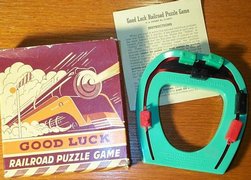 Good Luck - Saleable Products (Hordern J7) |
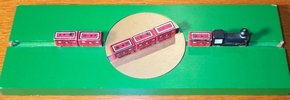 A wooden repro of a Protheroe-type turntable |

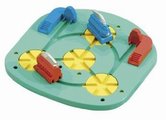 Metro by Binary Arts |
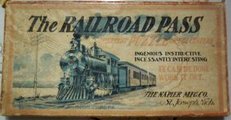
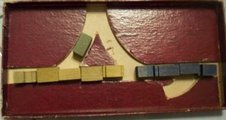
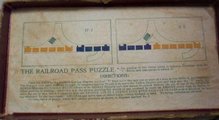 Napier - Railroad Pass (I don't have this.) |
|||

 Chifu-Chemulpo (Hordern E7) |
|||
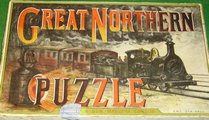
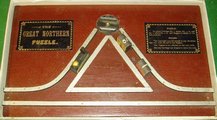 Here is a copy of the Great Northern Puzzle. (I don't have it.) |
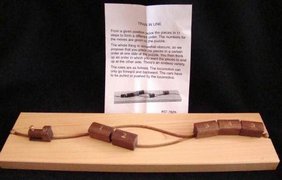
Train in Line - Bits & Pieces A nice wooden railroad shunting puzzle with 5 numbered cars. |
||
Here is my solution to the Wagon Works shunting puzzle. Start in the upper left and proceed left to right row by row down the page, ending in the lower right.
